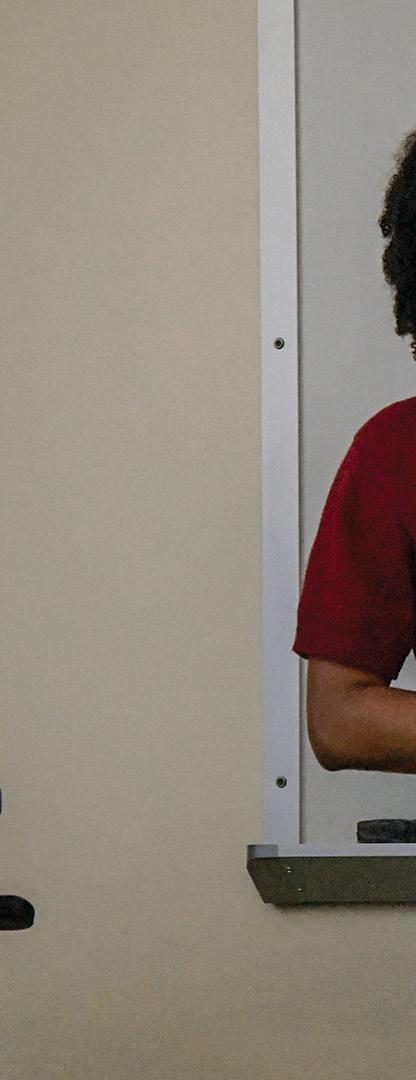




























































CELEBRATING STUDENT RESEARCH, SCHOLARSHIP, AND CREATIVITY




APRIL 22, 2025






















































































APRIL 22, 2025




















As President of Shippensburg University, it is my privilege to welcome you to Minds@ Work 2025.
Engagement in undergraduate research and creative pursuits is an increasingly important aspect of your higher education experience. Shippensburg University has a long history of providing impactful opportunities for our student scholars to engage in research and scholarly activities and to showcase that research and scholarly activity in Ship’s many academic disciplines.

Minds@Work prepares Ship students for the demands of graduate pursuits and introduces them to some of the concepts they may experience in their chosen profession. Students gain proficiency in their fields of study in preparing for Minds@Work, enabling students to bridge the gap between theory and practice by providing them with hands-on experience.
This event helps our student scholars to develop communication and presentation skills and allows them to practice articulating their ideas clearly and effectively. As a former undergraduate biochemistry researcher, I can personally attest to the value an experience like this brings to the professional world, where individuals must communicate and defend their ideas to colleagues, clients, and other stakeholders.
Minds@Work is made possible through the mentorship and expertise of our dedicated faculty. Students receive additional support from our dedicated staff and industry partners who provide insight into the ever-changing professional world. This annual event embodies the collaborative and scholarly spirit of Shippensburg University.
Congratulations to all our Minds@Work participants and thank you for sharing your scholarly pursuits with us each year and creating new knowledge in your field of study.
Charles E. Patterson,
PhD President,
Shippensburg University of Pennsylvania
Welcome to the 2025 Minds@ Work Conference, one of our University’s signature programs of academic excellence. This annual event is a powerful reflection of our unwavering institutional commitment to faculty-student mentorship, collaborative discovery, and the cultivation of scholarly identity across disciplines.

At the heart of this celebration is the dynamic relationship between students and faculty. Our faculty not only bring a wealth of expertise to their classrooms, but also actively engage students in meaningful research and creative endeavors. These collaborations are grounded in mentorship that fosters curiosity, inquiry, and critical thinking—hallmarks of a transformative collegiate experience. Through these close partnerships, students are guided to think deeply, explore boldly, and contribute meaningfully to their fields of study.
The Minds@Work Conference provides a unique platform for our students to showcase the results of their discovery, creative, and scholarly efforts. Today, they demonstrate their emerging identities as scholarpractitioners and reflect the depth of learning that comes from working alongside faculty on complex projects. These experiences are central to our mission of preparing students to be agile and thoughtful leaders who can navigate and contribute to an increasingly complex world.
The research and creative work displayed at Minds@Work is a testament to Shippensburg University’s strategic goal to “cultivate dynamic educational experiences.” Whether at the undergraduate or graduate level, these projects require students to examine critical questions, apply evidence-based thinking, develop strategic problem-solving skills, and engage in sustained inquiry. These experiences empower our students to confidently pursue further scholarly opportunities, including professional conferences, creative showcases, and peer-reviewed publications.
As a campus, we take great pride in this moment. Minds@Work is not only a celebration of student achievement, but also of the mentorship and dedication of our faculty who invest deeply in student growth. I am especially proud of the collaborative spirit that makes such learning possible, and I want to extend heartfelt congratulations to all of this year’s participants.
A special thank you goes to the Council on Student Research and Creative Activities and the Institute for Public Service and Sponsored Programs, with gratitude to Margaret Light and Kim Taylor for their leadership. I also want to recognize the SU Foundation for its continued support of the Joint Faculty-Student Research Program, as well as the many friends, alumni, and employees whose generosity sustains this important work.
Together, we affirm our shared commitment to a culture of inquiry, creativity, and mentorship. Let us celebrate the powerful outcomes of these efforts today and look forward to the continued growth of our students and their contributions to their disciplines and communities. I expect to be continually impressed by the caliber of our students and the mentoring they have received from our exemplary faculty.
Nicole R. Hill, PhD Interim Provost and Vice President for Academic Affairs
“People are generally better persuaded by the reasons which they have themselves discovered than by those which have come into the mind of others.”
—Blaise Pascal, Pensées
Faculty-student research is one of the hallmarks of Shippensburg University, exemplified by this Minds@Work celebration. We understand, as Pascal noted, that the process of discovery is extremely valuable for students. Prior to college, many students viewed education as static information being delivered to them. One of the goals of higher education is to demonstrate how dynamic our fields are and to encourage students to ask questions and cultivate curiosity. The pinnacle of the educational experience occurs when students delve into an area of interest and engage in the process of discovery themselves.

At our institution, research opportunities abound both inside and outside the classroom. Many programs incorporate project-based curricula and capstone experiences that require students to engage in research. There are also numerous ways students participate in research projects beyond the classroom. As a mathematics professor, I am particularly excited to see students engaging in interdisciplinary discovery when they apply their mathematical skills to data they collect and research they conduct in other departments.
As part of the research process at Shippensburg University, students are able to travel, collect data in the field, build prototypes, design marketing plans, engage in service to others, create artwork, all while working personally with our faculty. Faculty guide students in understanding the nuances of research within their disciplines, which often differ significantly, and teach them the appropriate methods for presenting and disseminating their work. Students showcase their research through posters, talks, panels, or performances. For many, Minds@Work serves as a dress rehearsal for presenting their work at regional, state, national, or international venues.
Research experiences provide students with the ability to play a central role in the educational process. By collaborating with faculty mentors, students gain firsthand experience in proposing and exploring complex questions, applying research methods, and contributing to the body of knowledge in their chosen fields. These experiences cultivate critical thinking, creativity, and resilience—skills that are invaluable both professionally and personally. According to the American Psychological Association, resilience is the process and outcome of successfully adapting to difficult or challenging life experiences, especially through flexibility and adjustment. In research, setbacks are inevitable: data analyses may lead to unexpected results, experiments might hit dead ends, or discoveries can be scooped by others. Navigating these challenges teaches students to adapt, persevere, and problem-solve effectively. Thus, engaging in research not only advances academic knowledge but also fosters the development of academic resilience in our students.
Congratulations to all of the participants in this year’s Minds@Work program. I am excited to see all of the amazing work being done by students and faculty.
Kimberly Presser, PhD Professor, Department of
Mathematics
On behalf of the Shippensburg University Foundation’s Board of Directors and staff, I extend our sincere best wishes to the students and faculty participating in this year’s Minds@Work conference. The Joint Undergraduate Student-Faculty Research Program has remained a central funding priority of the SU Foundation for decades. Over the past 10 years, the Foundation’s financial support for these collaborative research endeavors—has amounted to $558,398. This critical funding is made possible each year through the generosity of the Ship Family of donors. A Presidential grant from the SU Foundation’s Annual Fund, along with 13 dedicated endowments established by alumni and retired faculty, reflects the deep commitment to advancing undergraduate research at Shippensburg University. We are profoundly grateful for the financial support of our donors, which continues to create transformative opportunities for our students and faculty.

Through engagement in faculty-mentored research, undergraduate students gain invaluable experiential learning opportunities early in their academic careers. These students refine their presentation skills at the Minds@Work conference and demonstrate their research at competitive regional and national academic forums. Such experiences cultivate their confidence and preparedness for advanced graduate study at the master’s and doctoral levels. Moreover, former participants in this program have attested to the significant advantages their research experiences provided in securing admission to prestigious healthrelated professional schools.
The impact of this program is well established, and it continues to be a cornerstone of the SU Foundation’s fundraising priorities. We extend our best wishes to all students in their scholarly pursuits and express our profound appreciation to the Shippensburg University faculty for their exceptional mentorship and dedication.
Leslie Folmer Clinton,
EdD President and CEO Shippensburg University Foundation
Council on Student Research and Creative Activities (COSRACA)
Institute for Public Service and Sponsored Programs (IPSSP)
• Margaret Light, IPSSP Director
• Kimberly Taylor
Dr. William Braun
Dr. Laurie Cella
Dr. Joao Dias
Dr. Mengzhu Fu
Dr. Kirk Moll
Dr. George Pomeroy
Alix Rouby
Dr. Katherine Shirk
Dr. Joseph Zume
We would like to also thank the office of Student Affairs for providing refreshments for today.
Ameer Abdul’Wali
Kemi Adetunji
Davi Alfonso
Adolfo Avarez
Nana Yaa Ampaadu Mensah
Connor Baca
Jack Baer
Madysen Bihun
Emily Boger
Payton Burdette
Chase Burdick
Ashley Button
Caleb Christensen
Cejay Cocco
Elijah Cohen
Larissa Cooper
Talon Cortelyou
Steph Craven
Brayden Crawford
Aidan Crowder
Dan Diehl
Marc Dipiano
Cynthia Dodd
Alissa Dorsey
Matthew Ester
Cody Ferree
Thomas Firestine
Serena Fisher
Tyree Folkes
Marissa Foor
Cole Forbes
Connor Force
Elaina Georgelis
Haley Gilbert
Gavin Harris
Nathan Hetrick
Phylicia Hockman
Paige Holgate
Raychael Holtry
Joseph Hoyler
Josephine Hughes
Prabina Jogi
Meghan Keiser
Carol Khalil
Moses Kimotho
Bennett Kindlin
Kelly Krebs
Samantha Krzyzaniak
Owen Leese
Atlantis Leonard
Mackenzie Longworth
Lily Lopez-Garcia
Abby Lumadue
Micah Lyons
Mette Madsen
Jamee Mazonis
Eleanor Meckley
Aaron Miller
Katryna Moland
Kylie Montgomery
Ewan Moore
Abbie Morgan
Adam Mumper
Jana Nardis
Ekene Nwachukwu
Luke Ocker
Madison Ogden
Jaden Perrin
Alison Pioli
Aziza Porter
Madelyn Porter
Paul Posharow
Kyle Pritiskutch
Elena Pritt
Madison Rausch
Jamie Rettew
Alyssa Roadcap
Denise Rodriguez
Connor Rosko
Max Sadvary
Bailey Schwartz
Tyler Sherman
Alivia Snyder
Gregory Slovak
Ryan Stull
Jordan Tacas
Alex Tamassia
Zach Taylor
Mia Thayer
Kayla Thompson
Nathan VanNatter
Nicole Vela
Andrew Versis
Cambree Yonish
Gabriel Zerance
*Not all Undergraduate Research Grant Recipients will be presenting their research at this year’s conference due to the timing of the conference and nature of their research.
The Library Research Award is awarded annually by the Ezra Lehman Memorial Library in conjunction with the Institute for Public Service and Sponsored Programs and the Council on Student Research. This award recognizes the best literature review submitted by students who have received grant support for their participation in the annual Minds@Work Conference or by conducting other research with a faculty mentor. The first prize recipient receives a $1,000 cash prize and the honorable mention recipient is awarded a $500 prize.
Special thanks are owed to the late Professor Emeritus Berkley Laite ’67 and his wife Carol Laite ’65 who originally created and funded the early years of the Library Research Award. The Library Research Award is continued by the generous financial support of many friends of the library, through the SU Foundation.
This year’s winners are:
Winner: Olivia Kuntz, De-Extinction of the Thylacine: A Literature Review, Citation Style: Chicago Style, Dr. Christine Senecal (Faculty Advisor)
Runner-up: Nicholas Kornilow, Biochemistry and Safety of Aspartame Citation Style: CSE Style, Dr. Robin McCann (Faculty Advisor)
3:00 3:15 3:30
Biology Student Research Panel 3:30pm–5:00pm 3:45 4:00 POSTER SESSION 4:00pm–6:00pm
HISTORY AND PHILOSOPHY
The Assimilation of Ice Hockey: Sports and Indigenous Life 4:00pm–4:30pm POLITICAL SCIENCE United States Public Policy 4:00pm–5:00pm 4:15 4:30 4:45 5:00 CRIMINAL JUSTICE Beating the House: Card Counting and the Legal Framework of Gaming Regulation 5:00pm–5:30pm POLITICAL SCIENCE Public Policy: A Comparative Perspective 5:00pm–6:00pm 5:15 5:30 5:45 6:00
HISTORY AND PHILOSOPHY The Comparative Power of Comparative History 6:00pm–7:00pm
EXERCISE SCIENCE Movement Science and Skill Analysis 6:00pm–8:00pm CHEMISTRY Chemistry Undergraduate Research Symposium 6:00pm–8:00pm 6:15 6:30 6:45 7:00 7:15 7:30 7:45 8:00 8:15 8:30 8:45 9:00 8:30 8:45 9:00
3:00 3:15 3:30
Feminist Voices of Self-Identity: The Generative Criticism of Women’s Lived Experiences 3:30pm–4:45pm 3:45 4:00
COMMUNICATION STUDIES
National Identity: Essence, Evolution, Effects 4:00pm–6:00pm 4:15 4:30 MATH
Decay of Botox Within the Human Body: A Mathematical Study 4:30pm–4:45pm 4:45
GLOBAL LANGUAGES AND CULTURES
COMMUNICATION STUDIES
Explorations of Relational Communication: Student Research on Dating Behavior, Identity, Conspiratorial Belief, and Social Media 4:45pm–6:00pm 5:00
5:15 5:30 5:45 6:00
6:15
6:30
6:45 7:00 7:15 7:30 7:45 8:00 8:15 8:30 8:45 9:00 8:30 8:45 9:00
GLOBAL LANGUAGES AND CULTURES
Métamorphoses de Paris et de l’identité française : chaos, transformations et reconfigurations 6:15pm–7:15pm
ENGLISH Exploring Identity through Creative Nonfiction and Poetry 5:00pm–6:15pm ENGLISH
Shakespeare Everywhere: Creative Hacks of the Plays 5:00pm-7:00pm
ENGLISH Community through the Lens of the Photo Essay 6:30pm-7:30pm
The Minds@Work Program and the Undergraduate Research Program are just two examples of Faculty-Student Research which enrich Shippensburg University’s academic environment. Our thanks to all faculty members who supported students during the 2024-2025 Academic Year.
Dr. Moayyad Al-Nasra, Mechanical and Civil Engineering
Dr. Alice Armstrong, Computer Science
Dr. Lynn Baynum, Teacher Education
Dr. Sherri Bergsten, Biology
Dr. Lawrence Bailey, Political Science
Dr. John Bloom, History and Philosophy
Dr. William Braun, Exercise Science
Dr. Jamonn Campbell, Psychology
Dr. Allison Carey, Sociology and Anthropology
Dr. Laurie Cella, English
Dr. Dhiman Chattopadhyay, Communications, Journalism, and Media
Dr. Sean Cornell, Geography and Earth Science
Dr. Thomas Crochunis, English
Dr. Pablo Delis, Biology
Dr. Joao Dias, Mechanical and Civil Engineering
Dr. Alison Fedrow, Biology
Dr. Alison Feeney, Geography and Earth Science
Dr. Sam Florenza, Exercise Science
Dr. Michael Greenberg, Political Science
Dr. James Griffith, Psychology
Dr. Tim Hawkins, Geography and Earth Science
Dr. Sharnine Herbert, Communication Studies
Dr. Jeb Kegerreis, Chemistry
Dr. Christopher Keyes, Teacher Education
Dr. Emily Kramer, Biology
Dr. Marcie Lehman, Biology
Dr. Steve Lichtman, Political Science
Dr. Theo Light, Biology
Dr. Michael Lyman, Social Work and Gerontology
Dr. Paul Marr, Geography and Earth Science
Dr. Robin McCann, Chemistry
Dr. Luis Melara, Mathematics
Dr. Ben Meyer, Exercise Science
Dr. Blandine Mitaut, Global Languages and Culture
Dr. David Monaghan, Sociology and Anthropology
Dr. Suzanne Morin, Psychology
Dr. Shannon Mortimore-Smith, English
Dr. Allison Predecki, Chemistry
Dr. Matthew Ramsey, Communication Studies
Dr. John Richardson, Chemistry
Dr. Melissa Ricketts, Criminal Justice
Dr. Joohee Sanders, Exercise Science
Dr. Christine Senecal, History and Philosophy
Dr. Jonathan Skaff, History and Philosophy
Dr. Richard Stewart, Biology
Dr. Paul Taylor, Mathematics
Dr. David Wildermuth, Global Languages and Culture
Dr. Ying Yang, Sociology and Anthropology
Dr. Curtis Zaleski, Chemistry



































































































TIME: 3:30pm–5:00pm
Undergraduate and Graduate student researchers from the Biology department will discuss their work, showing the range of exploration in biology. Research topics include assessment of wildlife populations in Pennsylvania such as native range recolonization of sculpins, a new camera trapping technique for snakes, and analysis of topography and survivorship for snapping turtles. Anatomical studies in domesticated cats provide information about the role and variation within the Circle of Willis. Molecular genetic mechanisms were also investigated, using CRISPR to analyze genes involved in RNA processing, and cell migration assays alongside expression analysis to better understand the role of cellular recycling in cancer cell migration and metastasis.
Ameer Abdul’Wali, Kayla Beckner, Emily Boger, Hailey Green, Gavin Harris, Sofia Lopes, Eleanor Meckley, Naz Miner, Max Sadvary, Dakota Traver, Tashyanna Walters
Faculty Sponsor: Sherri Bergsten
This symposium will focus on the research projects performed by undergraduate chemistry majors. Research projects will include topics from the disciplines of analytical chemistry, biochemistry, inorganic chemistry, organic chemistry, and physical chemistry.
Serena Fisher, Kelly Krebs, Samantha Krzyzaniak, Abbie Morgan, Jaden Perrin, Madelyn Porter, Alivia Snyder
Faculty Sponsor: Jeb Kegerreis
TIME: 4:45pm–6:00pm CUB 226
Student panelists will present three group research projects that were conducted for COST 400: Senior Seminar in Communication Studies. Additionally, the panelists will overview the implications of their research findings.
1. The first project, “Dating in the Gaps: Examining the Relationships among Ghosting Intentions, Identity Gaps, and Ghosting Guilt,” explores the interrelatedness of identity discrepancies and datingbased communicative behavior.
2. The second project, “It’s All a Conspiracy: Investigating Conspiratorial Belief as a Predictor of Ethnocentrism and Intercultural Willingness to Communicate,” examines how conspiratorial belief may impact student-based ethnocentrism and students’ willingness to communicate with people from different cultural backgrounds.
3. The third student project, “To Troll or Not to Troll: Exploring the Relationships among Social Media Trolling Intentions, Tolerance for Disagreement, and Verbal Aggressiveness,” explores the relationships among social-media-based trolling intentions, trait-based verbal aggressiveness, and individuals’ levels of tolerance for disagreement. Phoebe Etchberger, Elena Facey, Kenny Griffing, Aniya Nesmith, Taneya Nixon, Griffin Patterson, Keeyana Reid, Trent Shade, Louis Sharpe, Alivia Snyder, Brynn Wagner, Onesty Washington
Faculty Sponsor: Matthew Ramsey
TIME:
Students enrolled in the Fall 2024 Communication Studies: Rhetorical Analysis course were tasked with conducting a generative criticism of various communication phenomena, which resulted in repositories of intrigue. While the directives were open-ended, students chose to explore topics that examine women’s experiences in diverse communication contexts. Their research specifically addressed:
• Imposter Syndrome Among Women in STEM
• Emotional Responses of Runners
• The Raw Feminist Voice in Cinematic Experiences
• Generational Black Excellence
• Celebrity Influence on Redefining Beauty Standards for Black Women Collectively, these papers contribute to grounding feminist voices and practices in the lived experiences of women. This panel amplifies these perspectives and fosters meaningful dialogue within the campus community, emphasizing the necessity and boundless possibilities of women’s experiences. Moreover, this panel aligns with the University’s mission to cultivate a culturally informed campus by advancing women’s voices across various contexts.
Phoebe Etchberger, Niyah Nesmith, Alivia Snyder, Brynn Wagner, Onesty Washington
Faculty Sponsor: Sharnine Herbert
TIME: 5:00pm–5:30pm CUB 103
Using math in blackjack in the casino to gain an advantage over the house and what the legality of how card counting works and your rights as a player and how the casino attempts to violate those rights.
Nick Effland
Faculty Sponsor: Melissa Ricketts
ENGLISH
TIME: 6:30pm–7:30pm CUB 240
In this session, three students will present Photo Essays that provide a window into a particular community. Each community provides its own support, encouragement, and rituals of belonging.
Shanely Casimiro, Jeremiah Clawson, David Dorsey
Faculty Sponsor: Laurie Cella
ENGLISH
TIME: 5:00pm–6:15pm CUB 240
This panel will feature creative writing, including poetry and creative nonfiction. These panelists will address focus on issues focused on identity as a trans man, trans relationships, the power of nature, love, loss, family, childhood experiences, comedy inspired by Shel Silverstein, and the teenage years.
Cynthia Dodd, French and Creative Writing, is presenting a chapbook “Transgressions, Reflections on My Trans Experience,” highlighting an essay about their teenage years called “The Monster” and some short poems about trans relationships.
Cooper Hendricks, English Literature and Communications, is sharing a collection of poems from the last year, covering topics such as childhood experiences and the power of nature.
Emmett O’Bell, Psychology, is reading some poems from his experience as a trans man, relating to love, loss, and his family. His poems are both playful and hard hitting.
Atlee Riordan, Math and Computer Science, is preforming several short comedic poems inspired by Shel Silverstein. The small collection of poems does not currently have a title.
Cynthia Dodd, Cooper Hendricks, Emmett O’Bell, Atlee Riordan
Faculty Sponsor: Laurie Cella
TIME: 5:00pm–7:00pm Orndorff Theatre
This session will feature student creative work inspired by five of Shakespeare’s plays that have been widely “hacked” by a range of cultures since their original composition in the English Elizabethan period: Romeo and Juliet, Julius Caesar, Othello, Twelfth Night, and The Tempest. Students from the ENGL 244 Foundations in Cultural Studies class will share a wide range of their creative representations of material from these plays and about Shakespearean cultural representations through live performance, media, creative writing, and critical commentary. After the presentations, participants will talk with the audience members about their creative work in response to Shakespeare’s plays and their cultural afterlives.
Keila Bittinger, Alcinda Burchill, Makayla Carr, Lizzie Engle, Dominic Gaudiano, Maria Gizas, Jacob Haney, Kaila Haverstein, Alex Heckman, Regan Henry, Lydia Lyman, Tomi May, Maggie Mooney, Bailey Riley, Kacey Sollenberger, Sarah Sprague, Jean Stinchfield, Jenna Tecchio, Ally Thrush, Ashley Toms, Alyssa Wert, Daniel Wintersgill, Bryce Wolaver, Kenton Woods, Steven Zerbe Faculty Sponsor: Thomas Crochunis
TIME: 6:00pm–8:00pm
This panel features a selection of noteworthy student projects from the Movement Science and Skill Analysis course (EXER 244). The session highlights the variety of interests of our students and includes baseball, softball, wrestling, track and field, and plyometric training. Presenters will provide background information, describe the methods used to examine the skill, and then share the results of their field-based research. The EXER 244 course provides students in the Exercise Science Major and Coaching Minor with initial experiences in the research process. The presentations in this session showcase the students’ first venture into research projects in the discipline.
Student presentations include: Softball Batting: Left Handed Slap vs. Right Handed Hit; Baseball Fastball Pitching: Comparison of Two Techniques; Wrestling Takedowns: Double Leg and Ankle Pick Techniques; Softball Pitching: Fastball, Screwball, and Curveball Techniques; A Comparison of Overhead Back and Between the Legs Forward Throws; and Shot Putt: Rotational and Glide Throwing Techniques.
JD Dorazio, Marissa Foor, Gian Greggo, Raychael Holtry, Anthony Horiates, Colby Houser
Faculty Sponsor: Ben Meyer
GLOBAL
TIME: 6:15pm–7:15pm
CUB 238
Ce panel propose une réflexion sur les transformations de la société parisienne et de l’identité française depuis 1789. La première étude, qui s’intitule « La reconfiguration de la société parisienne dans les œuvres de Balzac et Hugo », analyse la recomposition de la hiérarchie sociale et les mutations de la ville telles qu’elles sont représentées dans La Fille aux yeux d’or (1835) et dans Les Misérables (1862). La seconde étude, intitulée « Sur les traces du mauvais génie parisien, de Baudelaire à aujourd’hui », interroge la manière dont le mauvais génie baudelairien, reflet des anxiétés et des tensions créatrices d’une société en proie au désordre, continue d’incarner les tensions qui animent la capitale française. Enfin, la troisième étude, « Manifestations de l’identité européenne dans l’espace public français », examine les signes et les symboles de l’intégration européenne en France, et interroge les tensions entre identité nationale et supranationale. À travers ces trois communications, nous verrons comment Paris et la France se reconstruisent et se réinventent sur fond de chaos.
This panel explores the mutations that have shaped Parisian society and French identity since the French Revolution. The first paper analyzes the reconfiguration of Parisian social hierarchy and the transformation of the French capital city as they are represented in Honoré de Balzac’s La fille aux yeux d’or (1835) and Victor Hugo’s Les Misérables (1862). The second paper examines how the figure of the evil genius, summoned by French poet Charles Baudelaire to reflect the anxieties that stemmed from social disorder in nineteenth-century Paris, continues to embody tensions present in contemporary French society. Finally, the third paper examines the signs and symbols of European integration found in France, and explores the tensions between national and supranational identities. All three papers highlight how Paris and French society are reimagined in periods of chaos and change.
Cynthia Dodd, Selena Morrow, Morgan Tarr
Faculty Sponsor: Blandine Mitaut
TIME: 4:00pm–6:00pm
What is national identity? How is it created, manifested, transmitted, and how does it evolve? In this panel, students will consider these and other questions as they pertain to select nations across the Americas and Europe. Through these case studies, students will define national identity, explain its purposes and consider the challenges posed by globalization and competing identities, from regional to supranational.
Marlon Aristy, Faith Asbury, Gabbie Bower, Wes Shubert, Mason Smith
Faculty Sponsor: David Wildermuth
TIME: 4:00pm–4:30pm
CUB 103
From the early years of the eighteenth-century First Nation, or Indigenous, tribes of Canada had similar fates as the Indigenous children forced to attend Industrial Boarding Schools across North America. While Indigenous children were being assimilated so were various aspects of their Indigenous culture, one of these main aspects being their traditional sports. Sports such as ice shinny were adopted from Indigenous communities and adapted into a new, North Americanized sport for the world to watch and enjoy for themselves. As Indigenous sports continued to lose their traditional value, Indigenous students at boarding schools began learning new American sports to join professional leagues. Fred Sasakamoose, a student at Saint Michael’s Indian Residential School was taught ice hockey from a young age allowing him the pathway to become the first Indigenous hockey player in the National Hockey League, opening a new lane for future Indigenous athletes to follow in the years to come.
Rachel Fuhrman
Faculty Sponsor: John Bloom
TIME: 6:00pm–7:00pm
103
Students in Seminar in Comparative History, the capstone class for History BA majors, will present their research on topics in comparative history. This panel will demonstrate the comparative power of comparative history with each paper comparing and contrasting contemporary institutions, ideas, or issues that existed in two parts of one country, two different countries, or two world regions. Even though the specific research topics differ, the panel will have a collective goal of demonstrating how comparison can aid historians in gaining clearer understanding of distinctive historical patterns of individual cases, while often revealing previously unknown connections between the two cases.
Carlin Diehl, Shannon McNamara
Faculty Sponsor: Jonathan Skaff
TIME: 4:30pm–4:45pm CUB 240
In this mathematical study, we propose a mathematical model that simulates the dynamics of how Botulinum Toxin interacts with in the cholinergic nerve terminal. This process involves three steps, which includes initial binding, translocational, and lytic steps. We present some numerical results.
Madison Bihun
Faculty Sponsor: Luis Melara
TIME: 5:00pm–6:00pm CUB 104
This panel will look at public policies from countries other than the US. Paper topics include: Nuclear Power in France and US; the Afghan War and the Collapse of the USSR; The Poisoning of the Brazilian Amazon; Ian Thompson, Maria Luiza Takahashi, William Tenney
Faculty Sponsor: Michael Greenberg
POLITICAL SCIENCE
TIME: 4:00pm–5:00pm CUB 104
This session will cover a range of US public policy topics including: PFAS Litigation and Regulation; Political News on Facebook; The Rising Cost of Prescription Drugs in the United States.
Mark Hershey, Rachel Smoyer, Gianna Weigel
Faculty Sponsor: Michael Greenberg



































































































The Honors Symposium is the formal forum where Wood Honors College seniors present their capstone projects. The research, creative, and service-learning projects that our students present today represent the culmination of their academic experience in the Honors College. Thank you for joining us to learn about their projects and acknowledge their hard work!
TUESDAY, APRIL 22, 2:00pm–3:00pm
This research project focused on how prepared students at Shippensburg University are against phishing attacks. Over the last several years, phishing attacks have become more widespread and seem to target everyone, including universities. With this in mind, knowing how knowledgeable students are about phishing attacks is an important step in ensuring that students and the university are as prepared as possible for a targeted phishing attack. The data for this project came from a survey distributed to students which gauged students’ perceptions of their safety online and their ability to identify phishing emails. This data will be analyzed and compared with survey data from a previous project to see if students are becoming more aware of phishing scams over the years, or if more must be done to educate students about phishing.
Hunter Shoenfelt
Faculty Sponsor: Joseph Catanio
WEDNESDAY,
Amblyomma americanum has been found in the southeast and midwestern United States but current species distribution extends into Maine. Unlike other tick species, A. americanum displays aggressive host-seeking behavior and has been implicated in biting humans in the United States, making it of epidemiological interest. A. americanum ticks are known vectors of the causative agents of ehrlichiosis, tularemia, Rocky Mountain spotted fever, and viral diseases. Moreover, they harbor rickettsial agents of unknown pathogenicity, which can lead to competition among rickettsial agents The recent establishment of A. americanum populations in central Pennsylvania heightens the need for surveillance studies detailing the presence of Rickettsia species in local populations. Molecular analysis is being used to determine the prevalence of Rickettsia in Amblyomma ticks collected in central Pennsylvania. This study will contribute to the meager knowledge of Rickettsia species in Pennsylvania tick populations.
Larissa Cooper, Alyssa Roadcap
Faculty Sponsor: Alison Fedrow
WEDNESDAY, APRIL 23, 3:00pm–4:15pm
Proper dental hygiene is essential for maintaining oral and overall health. Poor oral hygiene can lead to bacterial buildup, increasing the risk of dental caries, periodontal disease, tooth loss, and oral cancer. Cavities result from complex interactions between microorganisms, diet, hygiene, genetics, and immunity. Despite being preventable, dental caries remain widespread due to inadequate oral care. Regular brushing and flossing, along with professional dental cleanings, play a crucial role in preventing these issues. This study analyzes the antibacterial activity of commercial anti-cavity products against oral streptococci and saliva samples from volunteers. Streptococcal isolates (both lab and human-derived) are subjected to disc diffusion assays to evaluate the effectiveness of selected antimicrobial compounds. The study aims to compare these compounds’ efficacy against different bacterial strains.
Nicholas Kornilow
Faculty Sponsor: Marcie Lehman
WEDNESDAY,
With the rapid growth of the kombucha market, verified techniques for its chemical analysis have become increasingly more important to quantify its main components. This research project developed an optimal analytical methodology using benchtop NMR to confirm acetic acid, sucrose, glucose, fructose, gluconic acid, and ethanol amounts in kombucha. A novel test system consisting of two brews utilizing pure glucose and pure fructose was prepared, one in a standard glass vessel and one in an air-permeable bag. Results support previous work suggesting that an air permeable bag is a more efficient brewing vessel than a traditional glass jar and demonstrate that a benchtop NMR yields comparable analytical results vs. traditional techniques of chemical analysis such as HPLC and GC-FID. Traditional methods can therefore be replaced or supplemented using a benchtop NMR spectrometer, which becomes a one-stop-shop for brewers to quickly and accurately measure the main components of kombucha.
Abbie Morgan
Faculty Sponsor: John Richardson
TUESDAY, APRIL 22, 12:30pm–1:30pm HRL 005
This project explored the basic concept and design of a hydraulic hand truck for easier lifting of heavy objects from the ground to elevated surfaces. Through research and development, we created a simple, yet effective solution to moving heavy loads. The project focused on affordability, practicality of use, and manufacturing methodology of this innovative product. While we do not refute the efficacy of manual hand trucks as well as electronic lifts, or even forklifts, we hope to demonstrate that our design provides a more cost effective and practical solution for the problem at hand—the need for swift and non-cumbersome means of vertical translation with little training needed to operate. Our goal is to achieve a working prototype to demonstrate our knowledge gained throughout this process.
Aiden Gonder
Faculty Sponsor: Fethi Belkhouche
TUESDAY, APRIL 22, 12:30pm–1:30pm HRL 005
When dealing with a large dataset, the use of a Database Management System (DBMS) is common to quickly and accurately access the desired data from the dataset. In SWE-415, we received a large dataset of their client data for 2023. This dataset consisted of millions of entries, so we used a MySQL, a SQL based DBMS to store the data. This database, however, ran into issues of slow query times and ElasticSearch was proposed as a DBMS that could replace the MySQL database and solve this issue. To test this, I have conducted an Empirical study in which I will compare this database to an equivalent ElasticSearch database to see if and when ElasticSearch is better. After this study, I found that ElasticSearch is generally better for tables greater than 12.5 million entries, but below this threshold, the noise generated by the systems makes the results inconclusive.
Noah Hays
Faculty Sponsor: Carol Wellington
TUESDAY, APRIL 22, 6:30pm–7:30pm HRL 005
The recruiting crisis facing law enforcement has caused much speculation on the impact of the media on the public’s perception of law enforcement. This study examines the impact of social media and portrayals of police on social media on college students’ interest in a law enforcement career and attitudes towards police. These variables were examined through a survey of criminal justice students at a university in Pennsylvania. Social media use was hypothesized to have an impact on both interest in law enforcement and perceptions of law enforcement. Findings revealed that negative portrayals on social media led to less interest in law enforcement among students. Positive portrayals on social media led to more positive attitudes towards police and less negative attitudes towards police. Negative portrayals led to more negative attitudes and less positive attitudes towards police. These findings could have significant implications on hiring practices by law enforcement agencies.
Sara Vosburg
Faculty Sponsor: Carlos Rojas
WEDNESDAY, APRIL 23, 5:00pm–6:00pm
005
The Ship ANCHORED program is a pilot program created at Shippensburg University for students ages 18-22 with intensive life skills needs. This program supports student development of social, self-advocacy, and vocational skills through work placement and instruction on a university campus. This research focused on developing instructional strategies for those who use Augmented/Alternative Communication (AAC) devices in workplace settings. A case study was used, working with one student who has extensive needs in using their AAC device. The goal was to support the student’s self-advocacy and communication skills. The unique environment where this research took place allowed for peer mentoring interaction with similar-aged university students. By focusing on self-advocacy skills and social skills, students in transitional life skills placements can further develop their skills in using their AAC devices to effectively communicate their wants and needs in a workplace setting.
Casey Harper
Faculty Sponsor: Thomas Gibbon, Ashley Gleeson
TUESDAY, APRIL 22, 12:30pm–1:30pm
HRL 005
TUESDAY, APRIL 22, 2:00pm–3:00pm HRL 005
The development of artificial intelligence, especially neural networks, to play video games is a common topic among researchers and developers alike. One game that has received very little attention in this regard though is the falling block puzzle game Puyo Puyo. Despite it having high potential for AI development, there’s relatively little literature on Puyo Puyo AI. As such, it’s not known how such an AI might operate, and what factors might affect its performance. However, in an attempt to produce Puyo Puyo-playing neural networks to answer these questions, the resulting networks produced unsatisfactory performance and seemed incapable of improving at the game. This paper outlines an attempted experiment to determine what factors might impact the performance of a Puyo Puyo-playing neural network, including relevant background literature and algorithms, how the Puyo Puyo neural network was built, and what factors are believed to have led to the networks’ underperformance.
Christian Honicker
Faculty Sponsor: Charles Girard
WEDNESDAY, APRIL 23, 5:00pm–6:00pm
HRL 005
When translating a text from one language to another, the process is much more complex than simply translating “word-for-word.” This common misconception does not acknowledge differences in semantics, syntax, and cultural relevance. Therefore, it is crucial that the translator translates a message or idea, rather than individual words and phrases. This takes creativity and cultural awareness of the target audience to rewrite the text in a way that will convey the original message with clarity and relevance. My research project explores this idea, focusing on specifically the translation of academic materials (2025 Reach Out Manual written by Kylie Montgomery and Elena Pritt) and how to adapt them for use at the Pathways of Learning School in Santo Domingo, Dominican Republic. The product of my research includes both the completed Spanish version of the 2025 Reach Out Manual and an analysis of the translation strategies and difficulties confronted throughout the translation process.
Sarah Oiler
Faculty Sponsor: Robert Lesman
Embedded digital marketing is an unavoidable aspect of entertainment. Product placement, paid product integration in media, influences customer behavior; however, its effectiveness and ethical implications are debated. My research examines the impact of both subtle and overt product placement on consumer attitudes, brand perception, and purchasing intent while investigating if either placement type invokes discomfort. Using quantitative and qualitative survey data, college-aged marketing students viewed clips containing an overt product placement, or a seamless placement. After viewing, participants answered questions evaluating their level of displeasure, likelihood of purchase, and personal experiences with product placement. Findings suggest that overt product placement correlates with a higher degree of viewer discomfort, but subtle integrations can enhance media immersion. This research contributes to ongoing discourse on advertising ethics and media brand visibility in media.
Sophia Stauffer
Faculty Sponsor: Michael Coolsen
WEDNESDAY, APRIL 23, 3:00pm–4:15pm
005
The performance of soccer teams is continually improving due to analytics. Factors associated with a team’s performance are passes between players and the formation of the players on the field. I examine passing sequences and tactical formations to analyze play to view different shot probabilities. The research considers the 2015/2016 season of the French Ligue 1 where two teams are analyzed, each playing two different formations and when the same formation is used by two different teams. A supervised machine learning model is used to determine the likelihood that a passing sequence ends in a shot on the opponent’s goal. An example is provided of how the framework can be used to test future sequences. Results from the study conclude that areas of success differ between formations and the teams using them while also showing the likelihood of a shot from a particular sequence differs between these and that the overarching success of a team is not representative of individual formations.
Aaron Kolaric
Faculty Sponsor: Grant Innerst
TUESDAY, APRIL 22, 2:00pm–3:00pm HRL 005
The goal of this capstone project is to design, manufacture, and test a pneumatic/hydraulic powered scissor lift on wheels to raise or lower the SAE BAJA buggy or similar equipment from elevated ledges for the Ship Engineering Lab. For reference, SAE BAJA is an engineering competition that the members of this project are involved in. This product would be broadly applicable in a variety of work environments for lifting and lowering equipment that is too heavy or just difficult to move by hand. More specifically, this product will be used by Ship SAE BAJA and the Morgan Engineering Lab, for purposes such as lifting the buggy for maintenance, or moving the buggy or heavy equipment in and out of the lab. This project applies engineering design principles applicable to real world industry, including but not limited to: iterative machine design; modeling and simulation using SOLIDWORKS; PERT project planning; manufacturing processes such as MIG welding; and non-destructive testing (NDT).
Ewan Moore
Faculty Sponsor: Joao Dias
TUESDAY, APRIL 22, 6:30pm–7:30pm HRL 005
During the winter months, snow and ice pose a major threat for concrete roads and sidewalks as repeated freeze-thaw cycles within the concrete can cause cracking and corrosion. This project investigates the use of paraffin oil as a potential method to limit snow and ice accumulation on concrete roads. Paraffin oil is known as a phase change material, which releases or absorbs high quantities of energy as it reaches phase transition zones. The paraffin oil was incorporated into a set of concrete slabs, which were placed outside during the winter months to determine if paraffin oil was effective at melting snow and ice off concrete. Additionally, the thickness of these slabs was varied to measure if changing the thickness of the slab impacted its ability to melt snow. These results were used to determine if paraffin oil could be a potential method for melting ice and snow off concrete roads and were applied to a real-life example of a bridge to demonstrate this possibility.
Kayla Vosburg
Faculty Sponsor: Moayyad Al-Nasra
TUESDAY, APRIL 22, 4:15pm–5:00pm HRL 005
For forty years during the 20th century, the Republican Party struggled to maintain control of the U.S. House of Representatives. As a result, party leadership developed various initiatives to gain political power. One of the most successful initiatives was Operation Redistricting Majority Project (REDMAP). It enabled Republicans to maintain control of the House of Representatives from 2012 to 2020 through an overwhelming campaign effort and subsequent control of the redistricting process. Previous work in understanding this plan suggests that this degree of gerrymandering was only possible through new mapping software, an unprecedented amount of unregulated money being spent on campaigns, and an organization able to capitalize on these new developments. This research attempts to better understand this paradigm shift and its implications for future elections using voter statistics, changes in district maps, and records on money spent on campaigns in each state.
Ethan Rosenberry
Faculty Sponsor: Alison Dagnes
TUESDAY, APRIL 22, 4:15pm–5:00pm
005
This study examined the impact of social connection and structured daily activities on loneliness and life satisfaction in adults aged 65 and older. With aging populations being at increased risk of social isolation and loneliness, it is important to understand these factors’ relationship to well-being, especially as the global population continues to age. Participants completed a survey assessing loneliness, life satisfaction, and structured daily activities. This study aims to find insights into how social engagement and structured routines influence overall life satisfaction and well-being in older adults.
Amanda Holmes
Faculty Sponsor: Amber Norwood
WEDNESDAY, APRIL 23, 5:00pm–6:00pm HRL 005
This study was designed to explore if an art therapy technique had a significant effect on anxiety symptom reduction in undergraduate students. Students (N=48) were randomized to either the control group: watching a show, or to the experimental group: participating in a guided paint night. Results indicated that there was a significant improvement in Beck Anxiety Inventory (BAI) scores for both groups upon the completion of the event, but there was no main effect of activity type on BAI score improvement, nor an interaction between time and activity type. Participants considered the event something that they enjoyed (71.4% rated 5 stars), but 76.2% (32 participants) stated that they would not be interested in participating in a future follow-up event.
Jacey Moyer
Faculty Sponsor: Suzanne Morin
TUESDAY, APRIL 22, 5:00pm–6:15pm
005
TUESDAY, APRIL 22, 5:00pm–6:15pm
This research explores integrating coding across the curriculum in a secondgrade classroom to boost student engagement. Four coding activities were implemented, including Scratch Jr, Code and Go Robot Mouse, Dash, and StopMotion. The study aimed to measure the impact on engagement using a mixed methods approach with pre- and post-surveys, student interviews, and observational data. Results show significant increases in student effort, with the StopMotion lesson having the most dramatic improvement on engagement. These coding tools not only enhanced motivation but also promoted critical thinking, problem-solving, and collaboration. The research highlights coding’s importance in fostering academic and social skills, making a compelling case for its integration into elementary education to enrich learning experiences and engagement.
Makayla Hall
Faculty Sponsor: Andrea Malmont
TUESDAY, APRIL 22, 5:00pm–6:15pm HRL 005
My research project examined students’ attitudes toward people with disabilities. I began by evaluating the effectiveness of various intervention strategies for teaching students about disability inclusion and promoting more positive attitudes toward children with disabilities. While existing research provides a basis for best practices, a gap remains regarding how frequently these methods must be employed to produce a significant change. My project, which involves children from my student teaching placement, seeks to study the effectiveness of best practice strategies implemented at different frequencies and their effect on student attitudes.
Amanda Fry
Faculty Sponsor: Allison Carey
Social-emotional learning, or how students make sense of themselves and the world around them through the acquisition of important life skills and attitudes, has become ever more important. However, it is not always given time or emphasis in education due to other academic obligations. One way social-emotional learning can be successfully implemented into daily classroom routines is through the use of children’s literature and intentionally planned read-alouds. The use of explicit instruction during read-alouds, including careful scaffolding, meaningful discussions, and extension activities, can enhance students’ development of these essential skills and related emotional vocabulary. This presentation will highlight the importance of teaching and reinforcing emotional vocabulary for young learners and how everyday routines, such as read-alouds, can be effectively planned and tailored in the classroom to support social-emotional learning.
Madalyn Helfer
Faculty Sponsor: Alison Mellott
TEACHER EDUCATION
TUESDAY, APRIL 22, 6:30pm–7:30pm HRL 005
Discussions with teachers at the Pathways of Learning School in the Dominican Republic emphasized a need for classroom management strategies. Our research concluded that there are three important components that are essential for improving classroom dynamics: Social Emotional Learning (SEL), creativity and imagination, and lesson planning with engagement. If teachers in the Dominican Republic were given more opportunities to gain further professional development on these topics, they may see a decrease in undesirable behaviors and an increase in more positive classroom interactions. Additionally, the increase of family partnerships between educators and students’ families, along with building a welcoming classroom community enables students to feel empowered and important. This curriculum compiles behavior management strategies, lessons, and extended learning activities that teachers can use to establish a more wellrounded classroom environment.
Kylie Montgomery, Elena Pritt
Faculty Sponsor: Christopher Keyes
TEACHER EDUCATION
TUESDAY, APRIL 22, 5:00pm–6:15pm
005
First graders’ development of affective empathy is necessary for a cooperative, peaceful classroom environment. However, Jean Piaget’s theory of cognitive development proposes that children do not develop abstract thinking abilities involved in affective empathy until the age of eleven. Meanwhile, research studies suggest children as young as six may develop such thought processes. Due to the potential for children six years and older to develop affective empathy and the need for affective empathy in promoting a positive classroom environment, I will investigate first graders’ ability to develop affective empathy. To do so, I will implement in my firstgrade student teaching placement three methods: read-alouds, dramatic play, and drawing. The aim of my research is to investigate the validity of Piaget’s theory of cognitive development and to determine which instructional methods, if any, best promote first graders’ development of affective empathy in the general education classroom.
Ashley Unger
Faculty Sponsor: Lynn Baynum



































































































5:00pm–6:00pm
CUB AIRPORT LOUNGE
Created in 2019 by Grace Klinedinst (Penney), a student in the John L. Grove College of Business, the Intern Showcase provides current students in internship positions with the opportunity to create a poster presentation about their experience. Grace was inspired by the Minds@ Work poster presentation sessions she attended to use a similar format to promote the value of internships for students. After moving to a virtual format during the COVID-19 pandemic, the Intern Showcase reach was expanded in 2023 to a university wide event open to all majors.
Most students understand that an internship will help position themselves competitively when looking for employment after college, but the majority of them do not fully understand what an internship experience entails. By meeting and interacting with current interns, students can ask questions directly to their peers and learn more about the benefits of integrating an internship during their time at Shippensburg University. Current interns can also offer guidance and tips on how to secure internship positions and how to make the most of the experience while working at their internship site.
Join us between 5:00pm and 6:00pm in the CUB Airport Lounge to learn more about the internship experiences of students in a variety of majors representing all of Shippensburg’s University Colleges.
The processes of autophagy and apoptosis are intertwined since autophagy is a cellular process in which the cell eats itself to digest damaged parts of the cell to deal with starvation or other stress in an attempt to avoid cell death or potentially as a precursor to cell death, apoptosis. Autophagy can act as either a tumor suppressor or a survival mechanism in cancer cells. As a survival mechanism, autophagy can provide nutrients, remove toxic materials, and ultimately assist mutated cells in becoming apoptosis resistant. When this happens, it becomes increasingly difficult to eradicate cancerous cells. This project aims to understand the relationship between autophagy and apoptosis regulation, as well as identifying genes associated with apoptosis resistance in the SNB19 glioblastoma cell line being studied. In previous work, apoptosis induction was studied in response to drugs, external factors, and fasting, with only minimal apoptotic stimulation. In current experiments, genes associated with apoptosis are being cloned from the SNB19 cell line and sequenced to determine if there are any mutations that could cause apoptosis resistance. Additional conditions and assays to detect apoptosis induction are also being tested.
Ameer Abdul’wali, Calyn Clements, Jana Nardis, Jordan Tacas
Faculty Sponsor: Sherri Bergsten
Clean water is an essential component for life and ensuring access to clean water is a priority for industrialized countries as water borne intestinal diseases can occur through transmission of pathogens via consumption or contact with contaminated drinking and recreational waters. Water contamination can arise from many sources: municipal sewage treatment effluent (although treated, still contains high numbers of intestinal organisms), personal onsite treatment systems (septic tanks, latrines and cesspools) which can leach into ground water, high volume and/or long duration rain events (which decrease the efficiency of sewage treatment) and agricultural/overland runoff (which can directly deposit fecal material into surface waters). Although many microorganisms are associated with water borne disease (enteric viruses, protozoal parasites, harmful algal blooms and bacteria), this project will focus on water borne bacterial pathogens due to the ease of culture and availability of validated identification protocols. Given the strong agricultural industry in Pennsylvania, coupled with the recreational use of the abundant park system (for swimming, boating, and fishing), the potential for water borne illnesses exists and represent a problem that must be monitored within the state. Past issues related to closures of beaches and parks due to microbial issues have occurred and tend to appear throughout the warm summer months, demonstrating the need for quick identification of disease-causing organisms to minimize the effect on human health. In this study, water samples were collected from local waterways and assessed for bacterial contamination by filtering different volumes (25ml, 50ml and 100 ml) to concentrate the organisms present onto standardized gridded filters. Filters were then placed onto different chromogenic media (Chromagar O157™, Chromager Salmonella Plus™ and Bile Esculin Azide Agar (Accumedia) and incubated for 24 hrs at 37 ºC to identify the bacteria present within the sample. Preliminary results indicate the presence of Salmonella sp., Escherichia coli and coliform bacteria in at least one sample collected from a recreational waterway. The identified organisms are often associated with human gastrointestinal disease. Water testing is ongoing, and positive samples will be subjected to biochemical analysis, if necessary, for further confirmation of the recovered bacterial species.
Payton Burdette, Ashley Button, Josephine Hughes
Faculty Sponsor: Alison Fedrow, Marcie Lehman
Amblyomma americanum (Lone Star tick) has historically been found in the southeast and midwestern United States; however, current species distribution extends up the eastern coast into Maine. Unlike other tick species, A. americanum displays aggressive host-seeking behavior and has been implicated in biting humans throughout the United States, making it of epidemiological interest. Amblyomma americanum ticks are known vectors of the causative agents of ehrlichiosis (Ehrlichia species), tularemia (Francisella tularensis), Rocky Mountain spotted fever (Rickettsia rickettsii), as well as viral diseases like Bourbon virus and Heartland virus (which can trigger Alpha-gal syndrome). Moreover, they are known to harbor rickettsial agents of unknown pathogenicity (Rickettsia amblyommatis), which can lead to competition among rickettsial (and related) agents. The recent establishment of A. Americanum populations in central Pennsylvania (Letterkenny Army Depot, Fort Indiantown Gap) heightens the need for surveillance studies detailing the presence of Rickettsia and Ehrlichia species in local tick populations. Currently, molecular analysis is being used to determine the prevalence of both Rickettsia and Ehrlichia in Amblyomma ticks collected in central PA. This study will contribute to the meager body of knowledge available concerning Rickettsia and Ehrlichia species present in Pennsylvania tick populations.
Larissa Cooper, Alyssa Roadcap
Faculty Sponsor: Alison Fedrow
Glioblastoma is a rapidly growing and aggressive brain tumor. Autophagy is cellular recycling that helps to maintain homeostasis especially in stressful conditions. As cell parts undergo damage or when nutrients are needed, autophagy is initiated so that the cells can deconstruct these parts and repurpose them into usable materials. It is beneficial because it can provide necessary building blocks for continued function and growth while also decluttering the cells. Starvation deprives the body’s cells of nutrients; and forces the cell to start recycling materials in order to function. Therefore, depriving the cell of nutrients triggers autophagy. Intermittent fasting is a pattern of eating in which an individual alternates between periods of eating and fasting (starvation).The impact that intermittent fasting can have on the regulation of autophagy in glioblastoma can potentially be applied to cancer biology and cancer treatment due to the roles of autophagy in protection of cells from harmful molecules, regulation of nutrient availability to meet metabolic needs, and ultimately coordinated control of cell survival and cell death. The effects of intermittent fasting on a DsRed-LC3 transfected SNB-19 Glioblastoma cell line were investigated using qPCR (quantitative polymerase chain reaction). Previously, three treatments were implemented on the cell line including a fully fed group in RPMI media, a starved group in only Hank’s Balanced Salts, and an intermittent fasting group that followed a 24 hours on: 24 hours off fasting protocol. Preliminary results suggest potentially important impacts on a range of cellular processes relevant to cancer. This year, the effects of adding different macronutrients including amino acids, growth serum, glucose and vitamins back into the starvation media were tested. The same 24 hours on: 24 hours off fasting protocol was implemented. Expression of genes that regulate autophagy, migration, apoptosis, and the cell cycle were measured by qPCR.
Fadekemi Adetunji, Leah Moffitt, Nicole Vela
Faculty Sponsor: Sherri Bergsten
The New Zealand mud snails (NZMS, Potamopyrgus antipodarum) have been invading aquatic habitats since the 1890s. A tiny freshwater snail that is easily transported on fishing gear, they have been able to invade countries in five different continents and have recently been found (since September 2022) in several limestone streams in Cumberland and Franklin counties. Invasive species tend to lower biodiversity and change food webs. We hypothesize that the presence of a large abundance of NZMS will alter the flow of nutrients through the food web from basal resources to invertebratefeeding fishes such as sculpins. In fall 2024, we collected snails along with other benthic invertebrates, plants, algae, detritus, and slimy sculpins (Cottus cognatus) from three locations: Branch Creek, Burd Run, and Big Spring. These are all limestone streams in Cumberland and Franklin counties that share similar plant and invertebrate species. Although all three have been invaded by NZMS, their abundance and the timing of invasion varies, with Branch Creek having a particularly low abundance likely representing a very recent invasion. With these samples we have identified, dehydrated, and ground up each organism for stable isotope analysis of carbon-13 and nitrogen-15. Both of these heavy isotopes exhibit distinct patterns as they move through the food web allowing us to trace the food web basal resources and trophic levels. We plan to determine mud snail and other invertebrate densities more precisely in each of these streams in spring 2025 using leaf litter bags, and will relate these densities to the findings of the stable isotope analysis. We are hoping this gives us insight to how rapidly NZMS can change the environment.
Alissa Dorsey, Jamee Mazonis
Faculty Sponsor: Theo Light
The invasive spotted lanternfly (Lycorma delicatula) continues to spread across Pennsylvania, threatening agriculture, and local ecosystems. Effective egg mass control methods remain understudied, particularly the efficacy of household remedies. This study aims to evaluate the impact of white vinegar, 70% isopropyl alcohol, spray paint, high-temperature exposure, and physical trauma on egg viability. Egg masses are currently being collected from Ailanthus altissima and other trees along the Cumberland Valley Rail Trail, with subsets left in the field and others stored under controlled conditions. Treatments will be applied, and egg mass viability will be assessed based on the percentage of eggs hatched when emergence occurs in April–May. There are variables accounted for that show that the lanternflies are unlikely to hatch before the end of the semester under field conditions but could hatch by late March or early April in the laboratory where some will be stored. Eggs within petri dishes in the laboratory will be monitored and once hatching commences, will be evaluated one week post hatch to observe viability. Findings from this study will contribute to the development of cost-effective and environmentally sustainable management strategies for controlling spotted lanternfly populations.
Nathan Hetrick
Faculty Sponsor: Richard Stewart
Camera trapping, in association with Adapted Hunt Drift Fence Technique (AHDriFT), is an emerging method in snake population surveying. Camera trap arrays allow for remote photographic capture of elusive species with minimal disturbance to wildlife. This study aims to analyze the effectiveness of camera trapping in comparison to traditional survey techniques, such as cover boards, at a rural site near Shippensburg, Cumberland County, Pennsylvania. In March of 2025, a camera trap array, consisting of a 15.2 m aluminum drift fence connected to a camera chamber at each end of the fence, was deployed at a local farm. This array was placed adjacent to one 2.5 x 1.2 m cover board to compare species identification quality and frequency. Coverboards and memory cards were checked monthly and photographs collected from the memory cards for later analysis. From the photographs collected, species identification, individual identification, and relative abundance of snakes, voles, toads, and small mammals may be determined at verifiable dates, times, and temperatures recorded by the camera. Northern Water Snake, Nerodia sipedon, Common Garter Snake, Thamnophis sirtalis, any many other species are likely captures due to the nearby pond and rural agricultural environment. We intend to pair camera trapping with traditional data collection techniques to assess the feasibility of camera trapping and its ability to expand current research of herpetofauna in the region.
Gavin Harris, Max Sadvary
Faculty Sponsor: Pablo Delis
Influenza A is a viral infection that annually causes substantial morbidity worldwide. The virus was first described as a contagious disease with high mortality rates being associated with poultry in 1878 and has since been shown to be transmitted to domestic poultry. The growing concern with Influenza A is the discovery that this virus does not just affect birds but also humans, cats, pigs, and many other mammals causing many deaths in ongoing outbreaks. Highly pathogenic avian Influenza (HPAI) H5N1 clade has pandemic potential and has been found all over the world and has a staggering mortality rate of over 50% worldwide in the last twenty years. The CDC has launched an investigation into the transmission of HPAI H5N1 from dairy cattle and poultry to humans in the United States during 2024, demonstrating evidence of transmission from dairy cows and poultry to humans. This study is currently undertaking assessment of milk samples (n = 50) (local/regional/national) (unpasteurized/pasteurized) for the prevalence of HPAI. Public health data of this undertaking is imperative to better understanding the transmissions risks of H5N1 (and associated influenza strains) among animals and humans.
Abby Lumadue, Allison Pioli, Tyler Sherman
Faculty Sponsor: Alison Fedrow
The Eastern Hognose Snake, Heterodon platirhinos, is an important species within the snake community in Assateague Island, Eastern Shores of Virginia. Located within the Chincoteague National Wildlife Refuge (CNWR), this population was reported as the densest ever surveyed in 1986. However, consistent with global trends, the Eastern Hognose Snake population at this protected site has seen significant declines. With this study, we intend to methodically survey the snake community at the CNWR, while also testing a novel technique, camera trapping, and providing snake relative abundance, recapture rates, and species diversity. In February 2025, we deployed four original trap arrays, comprised of 7.6 and 15.2 m aluminum fences and end-of-the-fence camera trap rigs, near standard galvanized cover boards 1.5 x 1.2 m to determine detection effectiveness and species identification quality. Coverboards were checked, and camera memory cards were collected, downloaded, analyzed, and compared to data from coverboards. Species, individual, morphological, and relative capture data were generated from the photos gathered. Expected data may include photo captures of high numbers of Black Racers, Coluber constrictor, as they outcompete and prey on the Eastern Hognose Snake population. Photo capture of mammals, toads, and other snakes is also expected. Camera trapping may increase the amount of data collected when surveying amphibians and reptiles, while maintaining manageable researcher time investment. If the data collected with camera trapping show extremely low densities, or the absence, of the Eastern Hognose Snake this will confirm the declining trends reported elsewhere. In the light of the ongoing biodiversity crisis, this more effective and economical technique will be highly useful.
Gavin Harris, Max Sadvary
Faculty Sponsor: Pablo Delis
In Pennsylvania, the gray fox population is declining with limited research about possible causes. We collected 43 hunter-harvested gray foxes (29 males and 14 females) sourced from western Pennsylvania during the Cresson Sportsman’s statewide coyote hunt on Feb. 14-16, 2025. During field necropsies, stomach and colon samples from each gray fox were removed and blood samples were taken when possible. Stomachs are currently being processed to isolate solid identifiable components of their diet. Solid components will be dried, weighed, and sorted into categories and frequency of item occurrence will be determined. The results will be compared with gray fox harvested from 12 different Pennsylvania counties and dietary components previously detailed in the literature. Colon samples will be evaluated for the presence of helminth eggs or oocysts later. Our aim is to analyze the diet of the gray fox and gain a better understanding of their diet that may explain why their population is declining.
Bennett Kindlin, Cambree Yonish
Faculty Sponsor: Richard Stewart BIOLOGY
In North America, Anaplasma phagocytophilum is known to be transmitted by the blacklegged tick (Ixodes scapularis) in the eastern US and the western blacklegged tick (Ixodes pacificus) along the West Coast. Anaplasma phagocytophilum is a prominent human and veterinary tick-borne pathogen; in 2001 A. phagocytophilum was shown to be the causative agent of human granulocytic anaplasmosis (HGA). HGA infections include parasitization of host neutrophils, and present with flu-like symptoms; severe cases can lead to significant mortality in immunocompromised patients. Tetracyclines are the drug of choice for treatment of A. phagocytophilum infections, and no human vaccine is available. A. phagocytophilum variants occur in both white-tail deer and humans. Our project is focused on detailing the prevalence of A. phagocytophilum in ticks collected in central Pennsylvania. To date, 176 ticks have been assessed for the Anaplasma, with a 1.5% positivity rate for the human/deer variants. This project will provide data of public health relevance for the state of Pennsylvania, regarding the presence/absence of the human variant in vector and wildlife populations in central Pennsylvania.
Jack Baer, Chase Burdick, Kyle Pritiskutch, Mia Thayer
Faculty Sponsor: Alison Fedrow
Protein synthesis is fundamental in maintaining cell structure and function. It is carried out in the cytosol of a cell, as the amino acid building blocks of a protein are delivered to the ribosome, the site of protein synthesis, by transfer RNA molecules (tRNAs). The tRNAs deliver the correct amino acids to the ribosome based on the coding sequence in a mRNA copy of a gene. tRNAs are synthesized in the nucleus and then processed, modified, and exported to the cytoplasm. Mature tRNAs are then constitutively imported back into the nucleus in a pathway conserved from yeast to vertebrates. This retrograde tRNA nuclear import pathway functions, in part, in proofreading tRNAs, as previous research shows that several types of aberrant tRNAs accumulate in yeast cells when this pathway is defective. Maintaining a pool of properly structured tRNAs charged with the correct amino acid is critical for the accuracy of protein synthesis. The goal of this research project is to detect aberrant tRNAs in cytosolic fractions from vertebrate cells to examine whether these aberrant tRNAs are present as they are in yeast cells.
Bailey Schwartz, Nathan VanNatter
Faculty Sponsor: Emily Kramer
Reservoir potential of wild canids in Pennsylvania for harboring parasites and pathogens that could affect humans, and our domestic animals has been understudied. The Red Fox, Vulpes vulpes, and the Coyote, Canis latrans, are two species that have stable populations and are increasingly present in human environments. During a public hunt located in Cresson, Pennsylvania, our team collected samples from hunter harvested Vulpes vulpes, and Canis latrans in three different Pennsylvania Counties. In the field, we had the opportunity to take samples from two male Vulpes vulpes, as well as two male and one female Canis latrans. To test for Sarcoptic scabiei mites, we scraped the surface of the skin, to include skin cells, and hair molecules to test. On top of the skin scrapings, we were able to keep full specimens from one Vulpes vulpes, and a singular head of Canis latrans that will be evaluated in more detail for mite presence. We will search for Sarcoptic scabiei mites using a microscope to determine if mange exists and could pose a problem for us or our domestic animals. If mange mites are identified, continued studies will need to be performed to better estimate the full reservoir potential of these wild canines.
Bennett Kindlin, Madison Rausch, Cambree Yonish Faculty Sponsor: Richard Stewart
A recent outbreak of Listeria in the common deli meat brand, Boar’s Head along with Listeria contamination reported in dairy products from wellknown retailers like Costco and Bristol Farms has increased concern for public health, in relation to foodborne illness. As seen and discussed in the news/print media throughout the years, foodborne illnesses are common and occur multiple times throughout the year with outbreaks involving many different bacterial pathogens (Listeria sp, Escherichia coli and Salmonella sp. to name a few). Public health remains a top concern during these outbreaks - most cases are self-limiting, but hospitalization and death can occur in cases of severe infections. In this study commercial food products were collected from local grocery franchises/sources. Samples were analyzed for the presence of Listeria, Escherichia coli and Salmonella using commercial indicator media (CHROMAgar Salmonella™, CHROMagar O157™ and CHROMagar Listeria™. Initial testing demonstrated the presence of both Salmonella and coliforms on lettuce samples, but the ground beef samples tested were negative for all pathogens. The CHROMagar Listeria commercial indicator media, when tested with the same products produced inconclusive results, demonstrating the presumptive presence of Listeria sp. but colonies will need further testing for conclusive identification. Lunch meat (turkey) was also sampled (n=6 retailers) but all samples were negative for the presence of pathogens. Product testing is ongoing, and positive samples will be subjected to biochemical analysis, if necessary, for further confirmation.
Tyree Folkes, Luke Ocker, Madison Ogden Faculty Sponsor: Marcie Lehman
The causative agent of human babesiosis (Babesia spp.) is primarily vectored by Ixodes scapularis (deer ticks). Babesia are eukaryotic microorganisms, known to parasitize host red blood cells; transmission to humans usually occurs via a tick bite. Although there is a possibility for human-to-human spread of Babesia (via blood transfusions), public health concerns are focused on transmission from deer ticks (abundant in the northeastern United States) to humans. Though some cases of babesiosis can be asymptomatic, there are cases of serious infection, causing prolonged/chronic symptoms, and possibly death (especially in immunocompromised patients). Symptoms associated with babesiosis infections in humans include fatigue, chills, muscle aches, increased thirst, air hunger, sleep disturbances, chronic inflammation; the most serious cases can result in death. Treatment options for Babesia infections are complicated and include a combination of antiparasitic and antibiotic drugs for prolonged periods of time. To date, ticks (n = 203) have been molecularly assessed by PCR assay for the presence of Babesia, with a 7.3% Babesia-positivity rate. With the published evidence suggesting that multiple species of Babesia are capable of causing human babesiosis, understanding the distribution of Babesia species in Pennsylvania ticks is an important facet of vector-borne public health efforts in the state.
Cejay Cocco, Lily Lopez-Garcia, Phylicia Hockman, Meghan Keiser
Faculty Sponsor: Alison Fedrow
This study presents the design, implementation, and performance evaluations of an innovative stormwater basin aimed at enhancing water quality and decrease downstream flooding. As urbanization increases, management of stormwater runoff and sediment control has become critical in mitigating the environmental impact of polluted water discharges. The proposed stormwater basin incorporates advanced filtration, natural sedimentation processes, and engineered detention features to optimize water quality before discharge. Incorporated in the research are detailed analysis of stormwater and sediment basins that are currently on the market. Through a series of field tests and modeled simulations the innovative stormwater basin has demonstrated similar pollution reduction characteristics to those basins currently used in engineering practice today. In addition, several parts of the innovated stormwater basin have been designed from scratch, tested, and redesigned to ensure reliability and functionality. This research highlights the potential of integrated stormwater management systems in addressing industrial drainage challenges.
Adam Mumper, Ekene Nwatchukwa, Ryan Stull, Zack Taylor
Faculty Sponsor: Moayyad Al-Nasra
For our Capstone project, we undertook the design of a highly innovative, self-sufficient, modern bridge. Incorporating aspects across steel and concrete design, geotechnical engineering, project management, CAD modeling, material analysis, and lab testing, our project encompasses a multitude of disciplines within the engineering sphere to maximize the efficiency and performance of our design.
Most notably, the concrete on the deck of the bridge has self-heating properties. In our research, we found that bridge maintenance is commonly concerned with the condition of the decking and its susceptibility to freezethaw cycles. Freeze-thaw cycles occur when water penetrates the concrete through pores and cracks. When the temperature reaches freezing, this water freezes, causing expansion (approx. 9%) of the concrete. This extra pressure can lead to cracking. Once the temperature rises, it melts back to water and contracts. This freeze-thaw cycle can enlarge the voids in concrete, which allows more water to accumulate during thawing. This can lead to more cracking during the next freezing cycle. Similarly, when ice develops on the surface of the concrete, it is often combatted with salt and other chemical treatments. These processes affect the chemical composition of the concrete, decreasing its longevity, and harm its compressive strength capabilities. By utilizing the properties of phase-changing materials (PCMs), we formulated a concrete mix embedded with self-heating abilities, negating the need for detrimental deicing techniques and protecting against the undesirable outcomes induced by freeze-thaw cycles.
To carry our functional concrete deck, we designed a multi-faceted steel bridge, making use of girders, spandrels, beams, and diaphragms to maximize the efficiency of load distribution while minimizing materials and costs. Tested by HS40 loading, our model passes all AISC and ASTM codes and requirements.
Our construction project management schedule details a comprehensive plan of the project’s duration. By employing finish-to-start, start-to-start, and finish-to-finish activity dependencies, our critical path method pinpoints dependent tasks while accelerating independent ones. Complemented by our activity cost analysis, our schedule optimizes construction productivity while minimizing potential delays.
Lastly, our project is illustrated by a 3D model. With this, audiences can gain an insight into the large-scale planning and robust design required to create such a feat. Aside from the self-heating concrete, it includes other selfsustaining elements such as solar panels and autonomous drainage methods.
Jacob Arnold, Tanner Lorson, Eve Nealon, Kayla Vosburg
Faculty Sponsor: Moayyad Alnasra
Mass media plays a powerful role in shaping public perceptions of diverse communities, influencing how race, gender, disability, religion, social class and other identities are understood by society. This poster session explores the ways different groups are portrayed in news, film, television, advertising, and digital media—examining issues of representation, bias, and authenticity. To develop these posters for the COMM 245 Diversity and the Media midterm project, students researched and analyzed how media narratives can reinforce stereotypes or challenge them, who is given a voice in storytelling, and what these depictions mean for society. Join us to unpack media messages, see beyond stereotypes, and engage with the question: who gets to tell the story?
Emma Fasnacht, Autumn Kratzer, Chloe Lightner, Emma Matlock, Kyra McClister, Madison Sharpe, Ashton Ulmer, Isabella Vallone
Faculty Sponsor: Dhiman Chattopadhyay
In the realm of artificial intelligence and game theory, AlphaZero stands as a pioneering model. DeepMind’s flexible model allows AI to learn to a point of mastery within stochastic game environments. At the heart of AlphaZero’s learning process lies its ability to extract meaningful patterns and strategies from the data it encounters. For my project I am interested in whether the completeness of information provided to AlphaZero significantly influences its ability to discern optimal strategies and make informed decisions. To study the differences I will implement two similar models assigned to separate environments with different information domains. These models will “master” their assigned environment and then will be applied to the environment with the other domain to see how well it can adjust. In this experiment we will not only be observing the speed in which the models can learn from a random initialized state but also how well each model can adjust to the new environment when switched. My Primary Objective is to determine how information completeness affects the performance (learning time and generalization) of Alpha Zero of a stochastic game.
The reason why this system can be used in various fields is because it takes advantage of modern computers’ ability to process information quickly and in parallel. Making the complex state trees of Stochastic games, the perfect test for AI and specifically Alpha’s capability. This idea isn’t recent, in the 1960’s Russian Mathematician Alexander Kronrod was in full support of using games, in this case chess, to push the field from its infancy. When this ideology was challenged by his peers, he didn’t capitulate but gave a premonition , “ chess was the drosophila of artificial intelligence” (Ensmenger,2011) which at the time was complete nonsense but in later decades, scholars understood the method to his madness. Now, there are many articles exploring this kind of implementation of AI. A notorious example is when DeepMind Technologies first introduced their studies and provided data that showed AlphaZero was able to perform at a level of mastery in many different board games through only self-play.
Ensmenger, N. (2011). Is chess the drosophila of artificial intelligence? A social history of an algorithm. Social Studies of Science, 42(1), 5–30. https://doi.org/10.1177/0306312711424596
Cody Rowe
Faculty Sponsor: Alice Armstrong
This study explored the psychological effects of holding the “surrender cobra” pose, typically associated with defeat, on mood and cognition. Participants held either a neutral or surrender cobra pose for three minutes before completing surveys measuring optimism, self-esteem, and affect. Contrary to expectations, there was a statistically significant difference in optimism and a marginally significant difference in positive affect in students holding the surrender cobra pose, in relation to the control.
Connor Baca, Denise Rodriguez
Faculty Sponsor: Jamonn Campbell
Work and productivity are considered core values in American society, yet disabled individuals who want to work still face significant barriers in securing employment. The state-federal Vocational Rehabilitation (VR) program exists to bridge this gap, but how effective is it? Do private charities and non-profit organizations play a role in outcomes? What are major job trends for the disabled community and what are employer attitudes? The data collected and research performed examines whether funding, unemployment, political ideology, and evidence-based practices, job choice, and private practices impact successful employment.
The findings challenge assumptions about what makes employment programs effective and highlight the ongoing struggle disabled Americans face in accessing the workforce. To effectively increase employment opportunities for disabled individuals, a critical reassessment of these programs is necessary, along with a shift away from equating worth solely to labor and productivity.
Lillian Sellers
Faculty Sponsor: Allison Carey
First graders’ development of affective empathy—the ability to understand what someone else is feeling in a given situation—is necessary for their cultivation of a cooperative, peaceful classroom environment. However, Jean Piaget’s theory of cognitive development, which informs educational theory and practice, proposes that children do not develop abstract thinking abilities, such as those involved in affective empathy, until the age of eleven. Meanwhile, research studies have reported that children as young as six years old may be able to develop abstract thinking processes that are involved in affective empathy. Due to the reported potential for children six years of age and older to develop affective empathy as well as the critical need for affective empathy in promoting a positive classroom environment, I have decided to investigate first graders’ ability to develop affective empathy in the general education classroom. To do so, I will implement in my firstgrade student teaching placement three instructional methods that have been identified as potential means of enabling first graders’ development of affective empathy: read-alouds, dramatic play, and drawing. The aim of my research is twofold: to investigate the validity of Piaget’s theory of cognitive development and to determine which instructional methods, if any, are more successful in promoting first graders’ development of affective empathy in the general education classroom than others.
Ashley Unger
Faculty Sponsor: Lynn Baynum
While meeting with the teachers at the Pathways of Learning School in the Dominican Republic, they emphasized a need for classroom management strategies within their school. Our research found that there are three important components that are essential for improving classroom dynamics: Social Emotional Learning (SEL), creativity and imagination, and lesson planning with engagement. If teachers in the Dominican Republic were given more opportunities to gain further professional development on these topics, they may see a decrease in undesirable behaviors and an increase in more positive classroom interactions. Additionally, the increase of family partnerships between educators and students’ families, along with building a welcoming classroom community enables students to feel empowered and important. This curriculum compiles behavior management strategies, lessons, and extended learning activities that teachers can use to establish a more well-rounded classroom environment.
Kylie Montgomery, Elena Pritt
Faculty Sponsor: Christopher Keyes
The island of Curaçao is facing nature versus development challenges. Runoff (nutrients, chemicals, etc.) from developing areas has been documented to cause algal blooms and impair reefs. An overabundance of certain types of algae can reduce the amount of sunlight that reef and seagrass areas receive. If algal blooms are too pronounced, severe oxygen depletion and dead zones can result, and most marine organisms living in and around reefs and SAV areas are impacted. This project investigates just how Curaçao’s shallow marine environments are being affected by development pressures. Given that seagrass and macroalgae that grow in coral reefs provide food and sanctuary for sea turtles, it is important to investigate the extent to which these ecosystems are being affected. In this study, photographs and videos of multiple reef environments taken in March 2025 during a trip to Curaçao, and from iNaturalist and other sources, will be evaluated for algal growth relative to the proximity to developed/developing areas. Analysis methods include using image software to make percentage cover estimations using grid overlay and point-count methods to measure/quantify density of macroalgae. By determining the abundance of algae, the relative amount of pollution can be qualified. Comparisons between reefs located adjacent to urbanized/industrialized areas versus reefs that are distant from development (i.e. lower chance of pollution) are compared to assess the relative impacts from development. By studying this topic, it can be better understood as to how Curaçao’s best natural resource (its reefs) is being affected. This study will also report on whether any meaningful action is being taken by the island’s government on this issue. This research will also suggest options for what can be done to improve the health of reefs.
Jaden Sutch
Faculty Sponsor: Sean Cornell
This is the third year in the history of the Ship BAJA team, and the second year of the Electrical Subsystem team existing. The role of the Electrical Subsystem team last year was limited due to financial constraints outside of the control of the team, and by lack of experience in what an electrical system should include/be capable of. This resulted in multiple minor oversights by the subsystem, such as no communications for the driver of the buggy and no way of directly knowing what was happening on the track. After two competitions, the team has learned about what works and what does not from other teams across North America and from online resources. While many teams have their own communications systems and even use live video feeds for watching what is going on specifically, the electrical team would like to replicate as much of this system as possible to allow some form of communication. The team this year has the goal of adding to the wiring harness and communications with the help of tools already in the Engineering lab and purchasing specific components to create our own electrical system and communications.
Cole Forbes, Micah Lyons, Matthew Swartz
Faculty Sponsor: Joao Dias
The proposed poster will address the lives of Jewish women in the early twentieth century when they arrived in America. The focus of this poster will be on “New Immigrants” who came to the country in the late 1800s, mainly from Southern/ Eastern Europe (Italy, Poland, Russia) and were mainly Jewish and Catholic. 2.5 million came from Eastern Europe, mainly pushed out by religious persecution. Immigration to the U.S. picked up in the 1800s due to rising instability in Europe. 44% of the 2 million Jewish immigrants who came to America between 1880s-1920s were women. Between 18201880 the Jewish population went from 3,000 to over 300,000. Between 1900-1915 over 15 million immigrants arrived at Ellis Island.
One of the main contributing factors to the rise in Jewish immigration were the Russian Pogroms. The term “pogrom” refers to violent attacks by local non-Jewish populations on Jews in the Russian Empire (Holocaust Encyclopedia). The influx of Jewish immigration was primarily fueled by two Russian pogroms, the 1917 Pogrom and the Kiev Pogrom. Tens of thousands of Jews were killed in the 1917 Pogrom which spanned from 1918-1920; the Red Army, Ukrainian Nationals, and Polish officials conducted their raids in Western Belarus and Poland. The Kiev Pogrom which lasted three years, killed over 100,000 Jews in Ukraine. It is believed that these attacks, their social acceptance, and the justification of blaming Jews for political upheaval laid the groundwork for the Holocaust.
The rest of the proposed poster will touch on historical events that would affect the lives of these women, The Triangle Shirtwaist Factory Fire, Women’s Suffrage, and World War One. All of these events sent extreme shockwaves through the Jewish Immigrant community.
Maggie Mooney, Gabrielle Stepan
Faculty Sponsor: John Bloom
This project focuses on Young Adolescent novels and its connection to engagement within classrooms. It explores the effects of providing choice for students whether that be through reading choices or choice-based activities, as well as teacher training methods to help foster reading practices and teachings to improve interests. I am currently working on methods for implementing and studying these approaches in my placement. I am student teaching at Greencastle Middle School in a 7th grade ELA classroom. I am currently gathering data on student reading choices. I am doing this by conducting surveys that center around their SSR books they are currently reading. I ask them a rating of the book, what genre they tend to cater towards, what page they are on, if they plan on reading the whole thing, what things they like/dislike, if they like the book that is within curriculum, etc. In doing this, I have realized the importance of pleasure reading/choice reading. In past placements I have found that students dislike the book read within the curriculum and love the SSR books they read- because they are given choice! This extends into how pleasure plays an important role in fostering reading engagement and development. Yet, pleasure is not found in schools, especially in reading choices and curriculum. The lack of pleasure behind reading, whether that be through choices or activities, is inhibiting students from growing as readers.
I will be conducting surveys, doing book tastings, having “First Chapter Fridays” and incorporating SSR throughout every morning for the bell ringers.
Emilia Conners
Faculty Sponsor: Shannon Mortimore-Smith
In this study, I explore ways in which to improve student engagement for writing in the English Language Arts (ELA) classroom by drawing on both classroom experiences and existing research. Teachers often struggle to balance the demands of standardized testing preparation with encouraging creativity and critical thinking — my research investigates alternative approaches that might bridge that gap. Strategies such as personal writing journals and individualized, meaningful feedback on writing assignments can assist in increasing student engagement and investment in their writing. I draw on research from educators such as Linda Rief and Maja Wilson to emphasize the importance of creating spaces where students feel comfortable expressing and advocating for themselves authentically. Through initial observations in the classroom and conversations with students during my student teaching placements (eighth grade and tenth grade ELA classrooms), I have noticed that there is a general consensus that writing is “pointless” among students. I aim to show that real-world examples of writing in ways that are not simply — write this essay — can build student writing stamina. These observations have shown that aligning writing instruction with student interests and experiences makes a difference. Ultimately, my research aims to offer practical ideas for making writing instruction more relevant to students’ lives and effective, helping students build not only their writing skills but also their self-advocacy skills.
Katie Huston
Faculty Sponsor: Shannon Mortimore-Smith
Prior research has found that lower body instability and shoe choice play a major role in running performance and injury prevention. Due to biological aspects, females are more susceptible to injuries compared to males. For collegiate female athletes to prevent injury and enhance performance, selecting a shoe with comfort and support is salient. Speed and cadence have shown to be direct factors towards running performance and contribute to shoe selection research. Shoe comfort, advertising, recommendation, and cost all contribute to shoe selection.
PURPOSE: This study was conducted to determine the differences in running speed, step frequency, and preference when running in a personal shoe, college shoe, and barefoot. It was hypothesized that sprint performance would be best and most efficient while wearing the college shoe.
METHODS: This study included 11 female student athletes (20.00±1.18 yrs). The athletes completed three forty-yard sprints under each of the three experimental conditions: personal shoe, college shoe, and barefoot. Each participant completed a visual analogue 10 cm scale to assess the perceived comfort, propulsion, and preference for each type of shoe.
RESULTS: Repeated Measures ANOVAs were used to analyze all variables. For sprint performance, there were no significant differences (p=.659) in sprint times between the school shoe (6.18±0.38 s), personal shoe (6.17±0.49 s), and barefoot (6.23±0.39 s) conditions, nor were there any significant differences (p=.129) in step count between the school shoe (22.24±1.25 steps), personal shoe (20.82±5.05 steps), and barefoot (24.02±3.80 steps) conditions. For shoe evaluations, there were no significant differences (p=.349) in perceived propulsion between the school shoe (6.33±2.36), personal shoe (7.13±1.88), and barefoot (5.29±4.01) conditions. There were, however, significant differences in perceived cushioning (p=.006), with participants perceiving more cushioning in their personal shoe (7.46±2.29) compared to barefoot (2.73±3.86). Similarly, there was a significant difference for overall preference (p=.011), with participants rating their personal shoe (7.85±1.86) higher than barefoot (3.72±3.91). While not significant, personal shoe was rated higher than college shoe on cushioning (6.35±2.38) and overall preference (6.62±2.08).
CONCLUSION: Sprint performance was not affected by type of shoe, contrary to our hypothesis. However, athletes did express a preference for their own shoe; their personal shoe was ranked higher than the other options on cushioning and overall preference.
SIGNIFICANCE/NOVELTY: As the type of footwear did not affect performance, yet athletes expressed a preference for their own personal shoe, teams may want to find ways to allow athletes to use their own shoe when possible, outside of competition. This could make training more comfortable and reduce the risk of injury.
Marissa Foor
Faculty Sponsor: Sam Forlenza
The advancement of smartwatch designs is a widely populated area within the technological industry. Smartwatches are specifically manufactured in accordance with the ability to accurately track heart rate and distance during varying activities and intensities. The high demand of these devices propose the question of their validity. Prior research examined the accuracy of different smartwatches during exercise, proving discrepancies. In the current study, 30 participants (17 female, 13 male) completed a modified version of the Bruce Treadmill Protocol to allow for collection of heart rate and distance throughout different exercise intensities. Participants were recruited for one day of testing, lasting 30 minutes. Heart rate and distance measurements were compared to the true recordings of a Polar Heart Rate chest strap and a Treadmill, respectively. Results displayed significant differences between the heart rate measurements of the Fitbit and Garmin compared to Polar. The Fitbit was found to be 95% accurate, Apple Watch was 97%, and Garmin was 93% in measuring heart rate. Results displayed significant differences between all three smartwatches in tracking distance: Fitbit was 83% accurate, Apple Watch was 79%, and Garmin was 33%. The overall results indicate that the Garmin Forerunner 45 was the least accurate when measuring heart rate and distance during submaximal exercise.
Mackenzie Longworth
Faculty Sponsor: Sam Forlenza
The type of preparation that exercisers utilize to get ready for their workout may influence their performance. Previous research has shown potential benefits on strength and endurance performance after using various music and physical warm-up methods. PURPOSE: The purpose of this study was to examine the effects of several pre-exercise preparation methods on bench press endurance performance. METHODS: 7 males and 3 females (age 22 ± 1 yrs) completed the study. Each participant had their heart rate (HR) and perceived energy level (PEL, via a 1 to 5 visual analogue scale) measured at 3 times: baseline (BL), post warm-up (PWU), and post bench press test (PBP). Participants completed four pre-exercise preparation methods (PEPM): control, music, physical warm-up, music + physical warm-up, and each condition was tested on a different day to ensure energetic recovery. Participants completed bench press repetitions to failure at 75% of their 1-RM. ANOVA tests were used to assess for statistical differences with a significance level of a = 0.05. RESULTS: A two-way ANOVA revealed that there was not a statistically significant interaction between the effects of PEPM and time (p = 0.07) for HR. Simple main effects analysis showed that PEPM (p = 0.43) did not have a statistically significant effect on HR, but that time (p < 0.05) did have an effect (BL 73 ± 14, PWU 81 ± 18, PBP 100 ± 20 bpm). A two-way ANOVA revealed that there was not a statistically significant interaction between the effects of PEPM and time (p = 0.96) for PEL. Simple main effects analysis showed that neither PEPM (p = 0.29) nor time (p = 0.54) had a statistically significant effect on PEL (BL 3.4 ± 0.8, PBP 3.3 ± 1.0). A one-way ANOVA found no effect of PEPM (p = 0.39) on bench press repetitions (control 14.3 ± 4.2, music 15.2 ± 2.9, physical warm-up 14.7 ± 3.3, both 15.7 ± 3.3). CONCLUSION: There were no significant differences between various pre-exercise preparation methods on HR, PEL, or bench press repetitions. SIGNIFICANCE/NOVELTY: Previous literature has shown promising results for the effects of music and a physical warm-up on muscular endurance. However, in the present study, music conditions did not influence performance or perceived energy levels of the participants. Consequently, the study results question the efficacy of using music as a strategy for enhancing performance under the testing conditions.
Olivia McElhenie
Faculty Sponsor: Joohee Sanders
With college students having many academic demands and responsibilities, they often feel high levels of stress. It is crucial to determine how this stress impacts physiological and cognitive functioning, agility, and strength. PURPOSE: To investigate the physiological and cognitive responses to a stressor in comparison to a controlled, non-stressful condition. METHODS: Twenty-three male and female college students (Age: 21.1±1.1 yrs, BM: 74.7±13.8 kg, Ht: 169.7±10.8 cm) underwent two separate testing sessions. During the first session, anthropometric measures, resting heart rate (HR) and blood pressure (BP) measures were taken. They also performed a hand grip test using a hand grip dynamometer, a 5-10-5 agility test, and a Stroop test. During the second session (Experimental Day), subjects were instructed to sit for five minutes before collecting their resting HR, BP, and perceived stress level on a scale from 1 to 10. Additionally, grip strength, agility, and Stroop tests were conducted. Next, subjects were informed that they would be giving a 2-3 minute speech on a complex topic, and that they would have five minutes to prepare. The subjects’ HR, BP, stress level as well as grip strength, agility, and Stroop test were performed and recorded. Lastly, HR, BP, and stress level were recorded a final time after revealing that they did not have to give a speech. RESULTS: Using repeated measures of analysis, changes in HR, BP, and stress level were examined. A paired sample t-test was run for agility, hand grip, and Stroop test. The mean HR was higher under stress (81.6±14.4 bpm) when compared to pre-stress (76.6±14.3 bpm) and then dropped post-stress (76.9±15.0 bpm) (p=0.24). The mean Systolic BP was higher under stress (124.7±10.6mmHg) when compared to pre-stress (120.5±9.6mmHg) and post stress (122.9±12.7 mmHg) (p=0.06). Stress level increased significantly under stress (6.1±1.4) when compared to pre-stress (4.1±1.1) and post-stress (5.0±1.3) (p<0.01). The agility test pre-stress took longer to complete (5.8±0.3s) than under stress (5.6±0.5s) (p=0.12). Handgrip strength was significantly higher under stress (36.4±10.3 kg) when compared to pre-stress (30.5±10.03) (p<0.05). Finally, time to complete the Stroop test was significantly lower under stress (18.3±3.4 s) than pre-stress (20.9±5.02) (p<0.01). CONCLUSION: Stressors on collegeaged students do not significantly impact physiological but do impact cognitive responses that can enhance their performance. SIGNIFICANCE/ NOVELTY: Academic performance is a common stressor in college students. The pressure to maintain good grades, meet personal expectations, and avoid disappointment can impact stress levels. Unmanaged stress can result in substance abuse, burnout, a decline in mental and physical health, and overall well-being. Recognizing this and how to manage it could benefit college experience.
Raychael Holtry
Faculty Sponsor: Joohee Sanders
Fasting is a popular method for promoting weight control and supporting metabolic health. The effects of fasting on exercise and cognitive performance are not clearly established. PURPOSE: to evaluate the effects of an overnight fast on physical and cognitive performance factors following a soccer training session. METHODS: The study included 9 male, university soccer athletes (age: 19.3±1.05 yrs.; 74.3±5.14 kg; 179±4.37 cm). Student athletes were training and actively competing in their spring season. Subjects operated as their own controls. During the first week of the investigation, on two testing days (CON Day1, CON Day2), immediately following a soccer training session, baseline control data were obtained for reaction time, cognitive performance (Stroop test), blood glucose, and shuttle run performance. One week later, subjects were instructed to perform an overnight and morning fast leading into their normal practice sessions on two experimental testing days (Fast Day1, Fast Day2). Once the practice sessions were complete, subjects repeated the tests listed above. Data were analyzed using one-way ANOVA. RESULTS: Reaction time was found to improve significantly (P=0.012) across testing days (CON Day1: 0.64±.02 sec vs. Fast Day2: 0.53±.02 sec) while trends were present for improved Stroop test time (P = .059) from Fast Day1(59.4±0.69 sec) to Fast Day 2 (53.4±2.84 sec) and for fewer Stroop test errors (P=0.065) over the same days (Fast Day 1: 3.5±1.01 vs. Fast Day 2: 1.3±0.53 errors). Neither blood glucose concentration nor shuttle run performance were affected by fasting or across testing days. CONCLUSION: Based on the study results, fasting was not found to impair performance on cognitive or skill tests. Improvements in reaction time and trends for Stroop test performance improvement may be attributable to a learning effect rather than an experimental effect. SIGNIFICANCE/NOVELTY: Further exposure to testing conditions, particularly where learning may occur, is warranted to gain clearer insight into whether fasting affects cognitive function and skill performance.
Andrew Versis
Faculty Sponsor: William Braun
Water, as a fundamental requirement for life, is perhaps humanity’s most precious resource. Not only do we depend on water directly, but we rely on ecosystems built upon its presence. A recent research article (Humphreys, 2022) reported on the extinction of all stygofauna on the island of Curaçao. Stygofauna refers to aquatic animals that live in groundwater systems such as aquifers and caves. In the case of Curaçao, numerous limestone systems are known across the island. In 1994, Wagner reported on sampling conducted from 1973-1984 where more than 50 species of the genus Halosbaena on Curaçao were identified. In contrast, sampling conducted in 2015 (Humphreys, 2022) showed a total absence of the genus as well as all other subterranean fauna on the island. This author proposed that this disappearance or extinction in crustacean organisms may largely be attributed to pollution and operations of the Isla Oil Refinery, which operated from 1918 until its closure in 2019 (pending future developments, it remains closed now). It is also likely that other factors may have influenced the quality of groundwater, such as saltwater intrusion and agricultural practices; possibilities which will be explored in this study.
This study focuses on Humphreys’ findings and the causes that he proposes for stygofauna extinction. The effort here is to further evaluate potential causes for such an extinction as well as the implications of this extinction event relative to conservation science and policies to protect sensitive, limestone-hosted groundwater systems from such kinds of impacts. In addition, during a March 2025 visit to Curaçao, an attempt will be made to determine if these organisms can be recognized in other areas of the island not sampled by Humphreys (who sampled during the end of the dry season). Sampling for stygofauna will be conducted using the Karaman-Chappuis method wherever possible. Ultimately, this study will investigate the extinction of stygofauna in Curaçao, explore possible causes, and formulate a timeline of events to provide context. This, in conjunction with prior research, will strengthen the argument for stricter environmental regulation in Curaçao and other island nations. Without regulation and enforcement, exacerbation of groundwater pollution on Curaçao is all but inevitable.
Vincent Cannizzaro
Faculty Sponsor: Sean Cornell
GEOENVIRONMENTAL SCIENCE
This study examines hammerstone collections from six sites along Carbaugh Run and five sites along Marsh Creek, both located on South Mountain, an area primarily composed of rhyolite, quartz, vein quartz, and metabasalt. Ours study focuses on the collection of quartzite samples. Sites 3 and 4 did not yield hammerstones for data collection. Various parameters were assessed for each sample, including the Wolman scale, diameter, and Krumbness scale. The results suggest that hammerstones are less common than previously assumed, showing a nonlinear trend of size reduction as they break down along their journey. This observation aligns with universal trends in river-bed sediments, namely fining and rounding, where particle size decreases and shapes evolve toward ellipsoidal forms. The study raises questions about the adequacy of the study area’s scope, the areas most prone to cobble erosion, and whether certain locations had been depleted of hammerstones or recently exposed by streambank erosion.
Crowley Bickert, Lauren Meiser, Fiona Valore
Faculty Sponsor: Paul Marr
GEOENVIRONMENTAL SCIENCE
Chronic Wasting Disease (CWD) is a fatal neurological disease affecting deer, elk, caribou, and moose, causing brain deterioration and eventual death. The disease spreads through direct contact and environmental contamination via saliva, urine, and feces. Due to its long incubation period, infected deer may not show symptoms, making early detection difficult. Since its first discovery in 1967 in Fort Collins, Colorado, and east of the Mississippi River in 2002, CWD has continued to spread across North America, Europe, and Asia. While there are no confirmed cases of human infection, experimental studies suggest the potential risk to non-human primates, prompting health and wildlife agencies to recommend caution when handling or consuming venison from infected regions.
This study utilizes Geographic Information Systems (GIS) to analyze spatial patterns of CWD cases and assess potential environmental factors influencing its spread in South-central Pennsylvania. Understanding the spatial distribution and spread of CWD is critical for mitigating its impact, particularly in regions where the disease continues to emerge. By identifying areas of high disease concentration and examining the role of geographic features, this research aims to provide insights into movement patterns and potential barriers affecting disease transmission. Elevation (DEM) and land cover data will be used to determine if mountainous regions act as natural barriers, while road networks and hydrology data will help identify possible movement corridors. By mapping and analyzing CWD case distributions, this research will help hunters, wildlife managers, and policymakers understand high-risk areas and potential spread patterns. The findings will provide insights into CWD containment strategies and inform disease surveillance efforts in Pennsylvania.
Nicole O’Connor
Faculty Sponsor: Alison Feeney
GEOENVIRONMENTAL SCIENCE
Curaçao, an island located in the southern Caribbean Sea, is part of the ABC islands, which also include Aruba and Bonaire. All three islands contain marine terraces formed by a complex set of processes acting over the past couple of million years. On Curaçao, there are at least four limestone terraces that encompass the outermost region of the island. The base of many of these dry terrace escarpments often contain bio-eroded and wave-eroded notches that represent former sea-level positions. This study investigates the lowest exposed or dry terrace that has been identified previously as containing a complex stratigraphy that includes two stratigraphic units, i.e. the Cortelein unit and the overlying Hato unit.
Through careful mapping and evaluation of rock exposures in the field and through LiDAR data, it is possible to unravel clues that allow a more detailed evaluation of past sea level positions. This study, therefore, investigates the topography, morphology, sedimentology, and stratigraphy of the lower terrace to unravel clues necessary to ascertain the formation mechanisms of coastal features along Curaçao’s terraces. In addition, these features will be compared to the most recent sea level curve reconstructed for the Pleistocene-Holocene interval from the Caribbean region with the goal of reconstructing sea-level positions in Curaçao. Field surveys, GPS elevation mapping, geomorphological analyses, etc., will help assess whether these features correspond to known glacial and interglacial activity or whether there are indicators for subsidence/uplift associated with tectonism. By integrating local geological data with sea level reconstructions, this research aims to refine our understanding of the island’s geologic evolution.
Nicole O’Connor
Faculty Sponsor: Sean Cornell
Curaçao is an island 45 miles north of Venezuela and located in the Lesser Antilles and southern Caribbean region. It is classified as semi-arid and has wet and dry seasons which are greatly affected by El Niño and La Niña. It is also directly in the path of the Trade Winds which create upwelling zones off the coast of Venezuela. These factors can have a large impact on moisture, transpiration, and plant life on the island. The aim of this research project is to identify and analyze key biogeographic differences and ecological zonation of plant taxa observed on the windward (NE) and upwind (SW) sides of the island versus those found on the leeward (SW) and downwind (NW) portions of the island. Plant descriptors such as (woody, vascular, and flowering) and georeferenced photos will be collected and obtained from iNaturalist for a GIS mapping and distribution analysis. This project will allow for a better understanding of plant diversity on the island as well as aid future biological research and help act as a current plant biodiversity assessment.
Sean David
Faculty Sponsor: Sean Cornell
GEOENVIRONMENTAL SCIENCE
During a field studies course in Northern Chile, our group of students including Sean David, Justin Ulneski, Raymond Lazar, Rebecca Wenschof, Justyn Padua and myself, accompanied by Dr. Paul Marr and Dr. Claire Jantz discovered an unrecorded petroglyph site in the Tarapacá Valley of the Atacama Desert. The site, although heavily disrupted, consisted of a collection of petroglyphs in geometric, anthropomorphic, and zoomorphic designs, along with an unusual sun shaped stone carving which resembled a nearby sun-like geoglyph. We documented the site by recording GPS coordinates and photographs at each petroglyph. This study aims to provide a record of this petroglyph field, analyze the frequency of the petroglyph types and compare them to those found at surrounding sites.
Lauren Wolford
Faculty Sponsor: Paul Marr
The erosion of aeolian dunes at the Savage Neck Dunes Natural Area Preserve has exposed an ancient soil horizon (paleosol) and an underlying peat/underclay layer, revealing a buried “ghost forest.” This study investigates the palynological (pollen) record preserved within these deposits to reconstruct past environmental conditions. Core samples from multiple locations were analyzed using sieving, centrifugation, and light microscopy techniques to identify pollen grains and assess shifts in vegetation over time. Preliminary results indicate a transition from arboreal-dominated taxa in the peat and underclay to non-arboreal grass-type genera in the paleosol, suggesting a warming-induced environmental shift. GPS mapping and aerial imagery were used to document the extent of the ghost forest and soil exposure, highlighting the ongoing impact of coastal erosion, particularly exacerbated by Tropical Storm Elsa. Further radiocarbon dating of preserved organic material, including pollen residues and a well-preserved pinecone, is necessary to refine the age and climatic implications of these findings. This study contributes to understanding Holocene environmental changes and emphasizes the urgency of documenting these fragile geological records before they are lost to coastal processes.
Fiona Valore
Faculty Sponsor: Sean Cornell
GEOENVIRONMENTAL
The goal of this project is to determine if the boulders located on south mountain are ploughing downslope or if they are being eroded out of the mountain. If they are ploughing is it due to freeze/thaw cycles? The research utilizes GPS and GIS technology to locate and map the boulders. Excel will be used for analysis.
Sean David
Faculty Sponsor: Paul Marr
GEOENVIRONMENTAL SCIENCE
Curaçao is a small island country (SIC) located in the Lesser Antilles in the southern Caribbean Sea. Like many other SICs, Curaçao relies heavily on tourism to support its economy. In recent years, with the closure of the island’s oil refinery, the tourism industry has exploded on the island. World Bank Group reported the per capita GDP for Curaçao to be less than $16,000 in 2000. Despite a downturn during the pandemic, this has skyrocketed to over $22,000 per capita in 2023. This rapid growth raises several concerns about the possible environmental and economic impacts of tourism on the fragile island. Understanding the impacts of tourism is key to ensuring sustainable long-term growth for Curaçao and other SICs. Thus, this study will explore the benefits of tourism in Curaçao by tracing the growth of tourism revenue over several years and describing the consequential impacts it has created due to expansion and development pressures. Historic imagery obtained from Google Earth and other sources will be utilized to map a timeline of land use change through recent decades. Additionally, the percentage of land converted for tourism growth will be mapped/assessed. Ultimately, the findings of this study aim to provide valuable insights into the benefits and detriments of tourism on SICs and inform options for sustainable growth policies on SICs using Curaçao as a case study.
Grace Coffman
Faculty Sponsor: Sean Cornell
GEOENVIRONMENTAL
Lithic reduction is an important primary step in the stone toolmaking process that involves removing excess mass from quarried rocks. Lithic reduction sites are often near quarries since transporting the waste rock is an unnecessary energy expenditure. Lithic reduction produces a substantial number of flakes and debitage as waste products. The remaining usable rock is often shaped into thin lithic blanks known as preforms for transport. The presence of waste flakes and broken or rejected preforms indicates that lithic reduction has taken place. All other rhyolite quarries in the region have nearby lithic reduction sites. This research was an attempt to locate the lithic reduction site associated with the Green Cabin quarries near the Carbaugh Run Natural Area on South Mountain. Surface surveying and test excavation units were conducted and did not reveal evidence supporting the presence of an associated lithic reduction site. These results suggest that local resources, such as water and food, were insufficient for even short-term visits and that more distant sites were preferable for lithic reduction.
Madilyn House
Faculty Sponsor: Paul Marr
GEOENVIRONMENTAL SCIENCE
Shippensburg’s
This study aimed to explore the urban climate of Shippensburg, PA by analyzing a possible heat island. This was achieved by placing temperature sensors and weather stations in multiple urban, suburban, and rural locations around Shippensburg. Measurements were recorded over a three-month period. Additionally, thermographic images were taken to analyze the surface temperature difference between urban and rural areas. A distinct urban heat island, most prevalent during 22:00 to 02:00 of around 2F° was found. Peak rural wind gust speeds reached almost double that of urban ones. Thermographic images revealed that urban areas and built structures were significantly warmer than rural areas.
Johanna Baker, Grace Coffman, Sean David, Adam Medaglia
Faculty Sponsor: Timothy Hawkins
GEOENVIRONMENTAL
Mangroves are a species of aquatic marginal trees that provide multiple ecosystem services which benefit their surroundings, support growth and development of local wildlife both above and below water, store carbon, filter water as well as provide coastal protection by reducing storm surge impacts, and trap and hold sediment reducing erosion. Thus, conservation and protection of mangrove ecosystems provide protection to coasts from the increasing impacts of storm surge, severe runoff, flooding and associated processes especially in the face of sea level rise. On the island of Curaçao, there have been some efforts to work on mangrove restoration, especially in anthropogenically disturbed areas (i.e. historic salt flats or salinas, industrialized sites adjacent to oil refinery operations, and near the former seawater distillation facility). This information is valuable because the land area of Curaçao is only about 0.55% mangroves according to UNESCO data. Essentially, mangroves are endangered and under threat due to coastal development, as are all of the other systems that depend on their health. Mapping and a photographic assessment will be conducted to assess mangrove forests, restoration projects and land area improvements in Curaçao. Along with this, further insight on educational efforts on the island to help improve the understanding and the value of mangroves will be done. Overall, this research will provide information on efforts being done to conserve mangroves, share their environmental importance and actions that need to be taken to further protect mangroves on the island of Curaçao.
Ally Calore
Faculty Sponsor: Sean Cornell
Geophysics, the non-invasive investigation of subsurface conditions, has been used in archaeology since the 1960s. It has proven to be an effective method of identifying archaeologic sites without requiring excavation and potential damage to these locations. The search for the Mary Ann Furnace, founded in 1762 and shut down in 1801, could be aided through detailed geophysical investigations. Ground penetrating radar (GPR) and magnetometry can be used to construct a detailed sub-surface image of an area to locate anomalies. These methods have consistently proven to be effective in aiding archaeologic investigations primarily as a tool to locate areas of interest (AOI). This study aims to determine the location of the Mary Ann Furnace through the production of radargrams and a magnetic anomaly map of the study area. Three GPR transects and two gradiometric transects were conducted along Black Rock Road to provide a representative image of the sub-surface. Due to high levels of background interference, the magnetic data was not suitable for analysis, however the GPR data was usable. The results of the GPR survey did not identify any anomalies consistent with a furnace salamander below the section of Black Rock Road surveyed. In accordance with the requirements of the research permits needed to conduct this study, a final technical report will be submitted to the PA Historic Preservation Office for inclusion in PA-SHARE. These findings will remain publicly available online for as long as the area remains on the historic register.
Samuel Rozanski
Faculty Sponsor: Joseph Zume
There are four primary rock formations on the island of Curaçao, Netherland Antilles, with the youngest being the limestone formations that ring the island. Pocket beaches on both the windward and leeward sides of the island are interspersed along the coastline’s limestone cliffs. These beaches contain a wide array of sediment clast types, some derived from erosion and weathering of the adjacent limestone terraces, as well as from offshore reefs that have been transported onshore. Other clasts are derived from the three rock formations found more to the interior of the island. These were evidently transported under diverse climatic and sea level conditions that are not well represented by modern environmental conditions, and therefore their provenance is not well understood nor are the conditions responsible for their transport and deposition to these pocket beaches.
As such, this study will investigate sedimentological characteristics regarding the provenance of interclastic, polymictic conglomerates found along the coast of Curaçao. Playa Santu Pretu, a small pocket beach, and Playa Santa Cruz, a maintained beach, located along the western coast will be analyzed (among others) to determine differences in composition, color, angularity, sphericity, etc. and how these differences relate to the underlying geology of Curaçao. A stratigraphic analysis will be conducted along the coastline to provide insight into sediment transport and deposition both today and in the past. Sediment samples will be collected and be analyzed for their grain size distributions and for microscopic examination. Geolocated and scaled photographs will be taken and clast angularity and sphericity will be assessed using ImageJ software to take measurements of each clast and their shape. Hjulström’s diagram will be employed to correlate sediment characteristics with hydrodynamic conditions. These findings will greatly contribute to further develop the understanding of sedimentation on Curaçao, offering broader implications for coastal geomorphology in carbonate-rich tropical systems.
Page McGovern
Faculty Sponsor: Sean Cornell
The Quaternary (2.58 to 0.012 million years ago) sedimentary record of the Eastern Shore of Virginia was deposited during a time of significant fluctuations in sea-level. Prior research has shown that high frequency eustatic sea level rise/fall events (averaging ~125 meters per cycle) had a recurrence interval of about 100,000 years (at least for the last 800,000 years) and were driven primarily by orbital variations associated with the Milankovitch eccentricity cycle. During high stands of sea-level (i.e. global warm climate conditions), water levels rose up to and above modern sea level. Sediments were eroded, transported, and deposited in shallow marine environments not unlike the barrier island/bay/marsh systems observed today. During each cycle, new deposits migrated landward and welded onto previous high stand deposits resulting in a complex set of parallel ridges and barrier spits that formed from north to south and resulted in the current configuration of the Delmarva Peninsula. During subsequent regressions (global glaciations) sea levels fell, marine environments migrated eastward, the terrestrial shelf widened, and fluvial processes cut downward into previous deposits. In addition, aeolian processes during cooler climate conditions redistributed sediments, flattened upland areas, formed some dune and Carolina Bay systems. The latter are shallow rimmed depressions (circular to elliptical in shape) that are still poorly understood, but are prevalent on the upland landscape today and are readily observed in LiDAR. This study evaluates the easternmost set of bluffs that are now being exposed on the shore of Chincoteague Bay (SW of Greenbackville, VA) by rising sea levels. Recent erosion at several locations has exposed strata mapped by Mixon (1985) as post-Pliocene Accomack Member of the Omar Formation. Omar strata have been documented through core and limited quarry exposures, yet their age, geologic origin, and significance relative to glacial-interglacial chronologies remains poorly resolved. Through our work, we have identified at least five distinctive depositional units within these exposures. These suggest a more complex environmental history than what is currently understood. Moreover, LiDAR mapping shows some alignment with a NE-SW-oriented feature mapped as the Metomkin scarp further south. However, several scarps merge northward and are likely composited in northern Accomack County. This study reports on the first Ground Penetrating Radar (GPR) investigation of the scarp at Wallops Island National Wildlife Refuge. The newly obtained GPR datasets are being investigated in tandem with sediment data from Powell’s Creek and from Swan’s Gut/Sinnickson. The presence of a newly recognized paleosol (here named the Powell’s Creek) and overlying lagoon deposit both located above modern sea-level suggest an MIS 5e age (or possibly older) age. Although further investigation is needed, this work is already providing additional insights necessary to resolve the record of environmental change on the Eastern Shore prior to the onset of the present Holocene rise.
Page McGovern, Nicole O’Connor
Faculty Sponsor: Sean Cornell
GEOGRAPHY AND EARTH SCIENCE
Overfishing of herbivorous fish, such as parrotfish and surgeonfish, reduces grazing pressure on macroalgae, leading to algal overgrowth on coral reefs. Combined with nutrient pollution, this inhibits coral recruitment and intensifies competition for space and resources. Unchecked algal growth accelerates reef degradation and erosion, a phenomenon documented across the Caribbean, including Curaçao. Studies, such as Bruckner & Bruckner (2003), have shown that heavy fishing pressure correlates with increased algal cover, making reefs more vulnerable to disease and environmental stressors. This study assesses the relationship between herbivorous fish populations and reef health in Curaçao through field surveys (March 2025), GPSlocated i-Naturalist records, and underwater imagery. Comparisons between overfished and protected reefs, identified via Landsat satellite imagery, will be analyzed using GIS to track long-term reef health. The findings will provide insight into the ecological consequences of overfishing and inform conservation strategies. It is hypothesized that continued overfishing will reduce algae grazing, increase algal overgrowth, and accelerate coral reef loss in Curaçao.
Logan Kramer
Faculty Sponsor: Sean Cornell
With an increase in technology and globalization, it is important to ensure Agricultural practiced conform to the needs of the surrounding landscape to keep the environmental risks low and as pristine as possible. Traditionally, Caribbean islands are known for producing products such as tropical fruits, alcoholic drinks, and sugar cane. However, this is not always the case, such as on the island of Curaçao, which lacks the rainfall that many other islands have.
This research project aims to understand the status of Agriculture on Curaçao, the kinds of techniques the farmers use, what they are growing, and food security/biosecurity on the island. Techniques could range from regenerative agriculture (low till, crop diversity, cover crops) to conventional practices (heavy machinery, chemical sprays, monocrop) and traditional agriculture (manual labor, natural fertilizer, generational knowledge). Local farmers/gardeners will be surveyed to understand their techniques and the crops grown. Basic soil assessments Will be undertaken to analyze the soil composition and determine soil health. The results of a soil assessment can help explain current agricultural practices and why certain crops are grown. Food security will be measured by mapping out what parts of the island have walking access to a farm, market, or grocery store. Biosecurity can be a significant issue due to the introduction of pathogens and other risk factors that can impact food safety on the farm. On some Caribbean islands, livestock are not always kept within fenced areas and many animals have free range which can introduce potential biosecurity risks. Biosecurity risks will be mapped out and cross referenced with the location of farms and markets to find potential areas of biosecurity risks.
Matthew Hoover
Faculty Sponsor: Sean Cornell
My research question in the field of political science is “Would the reforms Americans are discussing be effective in reforming our Supreme Court?” To answer this question I have found the most common reforms Americans and political scientists have been discussing within political think tanks. These include: adding term limits; adjusting the number of justices on the court; and legislation against court-packing in preference of one political party. To determine the success of these reforms I am conducting a literature review comparing countries that have implemented these reforms in their courts and the success they have compared to the United States. This allows me to determine how well these reforms would perform here. Naturally many countries differ in their political systems, so the countries that have implemented these reforms will be chosen to be compared based on their compatibility with the United States, for example prioritizing observing capitalist democracies.
Paige Holgate
Faculty Sponsor: Lawrence Bailey
The Black-Scholes equation is an important model in the world of pricing financial derivatives. The formula appears over whelming at first glance, so the research began with developing foundational financial knowledge associated with the financial derivatives known as options. As research progressed, the focus centered on understanding the use of binomial trees and eventually the Black-Scholes formula to price options. The project culminated by studying a proof showing the divergence of the binomial model to the Black-Scholes equation. Ultimately, a detailed understanding of pricing financial derivatives was developed, and this knowledge will be of great use during further studies of financial mathematics.
Hayden Schetrompf
Faculty Sponsor: Paul Taylor
MECHANICAL AND CIVIL ENGINEERING
This is the third year in the history of the Ship BAJA team existing. The role of the drivetrain subsystem team last year was limited due to financial constraints outside of the control of the team, and by lack of tooling being unable to CNC a lot of parts like other SAE BAJA teams. This resulted in the team purchasing a complete off the shelf differentials. After two competitions, the team has learned about what works and what does not from other teams across North America and from online resources. While many teams CNC machine each of their system’s components from scratch, the team this year has the goal of machining certain components with equipment already in the Engineering lab and purchasing specific parts to construct our own personalized drivetrain system.
Thomas Firestine, Jamie Rettew
Faculty Sponsor: Joao Dias
This research topic is the responsibility of the Steering Subsystem team of the Shippensburg University Intercollegiate Chapter of SAE BAJA, less formally called the Ship SAE BAJA team. The Steering Subsystem team has outlined several specific goals for the 2024-2025 buggy, with specific measurable targets to quantify achieving them. The team has decided they want to go with a rack-and-pinion style steering mechanism, where the steering wheel shaft links to a gear that rolls a rack left and right, which moves the tie rods connected to the wheels to steer. This style is simple but robust, with parts that will be able to withstand heavy impacts and loads during driving without losing precision. The first and primary goal is to reduce the size of the rack to less than 8 inches, approximately half the length of the previous year’s mechanism. This will reduce the weight, contributing to gains in speed and maneuverability of the buggy. To accomplish this, the steering ratio will need to be decreased to approximately 8:1, meaning the gear of the pinion will have to have a higher tooth count to move the rack further with less rotation. In other words, it will take less rotations of the steering wheel to move the front wheels. The second goal is to increase the steering angle of the buggy, which is a measure of how far the wheels can turn from neutral, to approximately 170 degrees. This can be done with extended tie rods connecting the wheel to the rack. The third goal of the steering system is to improve ease of maintenance on the system, which will need to be done in conjunction with the Chassis Subsystem team. Last year’s buggy had difficulties with removing and installing the steering rack due to where the mounting points could fit in the front chassis compartment, and simplifying/improving those points would help with maintenance in the lab and at the competition. Finally, the last goal is for the Steering Subsystem team to take detailed notes and data collection. Several different detailed simulations and physical testing experiments will yield useful data for the Design Review component of the competition. That being said, each component of the steering system will be designed and manufactured to meet these goals.
Connor Force, Ewan Moore
Faculty Sponsor: Joao Dias
The Chassis Design team has outlined several specific goals for the 20242025 buggy, with specific measurable targets to quantify achieving them. The team has decided they want to go with a reduced size chassis, where the constraints of the design will make it more competitive. This will not only reduce the overall weight of the vehicle, but also bring the center of gravity of the chassis closer to the ground. The primary goal is to reduce the overall length of the chassis by 3 ft., the current length is 9 ft. and much of the components could be condensed. This will in turn reduce the weight, contributing to gains in speed and maneuverability of the buggy. To accomplish this, the chassis will be designed with these new constraints and manufactured as close to specifications as possible. The second goal is to reduce the height of the vehicle, which will lower the center of gravity and make the buggy less vulnerable to rollover. This can be done by reducing the cockpit constraints to fit smaller drivers as the previous model was designed for a 6’5” driver. The third goal of the Chassis Design team is to have the chassis withstand a rollover, this can be tested with the model in SOLIDWORKS. Last year’s buggy would not have been able to withstand a rollover as the weight of the engine would cause rear members to fail, the new design should accommodate this. Finally, the last goal is for the Chassis Subsystem team to take detailed notes and data collection. Several different detailed simulations and physical testing experiments will yield useful data for the Design Review component of the competition. That being said, each component of the chassis will be designed and manufactured to meet these goals.
Daniel Diehl
Faculty Sponsor: Joao Dias
PSYCHOLOGY
Peer mentoring programs are beneficial as they may increase student involvement and inclusion within universities. This study investigates how attachment quality and mentor self-efficacy influence mentor-mentee relationships. Eighteen participants, nine mentors and nine mentees, filled out surveys assessing their attachment style, perceptions of mentor selfefficacy, and perceptions of mentor support. Findings suggest that mentors with greater anxious attachment, and mentors with higher self-efficacy, are likely to provide greater mentor support.
Elaina Georgelis, Aziza Porter
Faculty Sponsor: Ashley Seibert
The purpose of this study was to investigate the effects of painting and drawing centered art therapy on anxiety reduction in college and university students. It is important to understand the effects of art therapy on reducing the symptoms of anxiety in college students in order to better understand how the current therapy practices that are implemented on college campuses can be revised to better suit the needs of each student. The activity involved two groups of roughly thirty university student participants, recruited through SONA, and followed an experimental design and quantitative methods: one who completed a paint night and the other a control group, both analyzed with pre and post-tests. Both groups filled out a questionnaire which included the Beck Anxiety Inventory at two separate times, and this difference was analyzed for the results of the study.
Jacey Moyer
Faculty Sponsor: Suzanne Morin
It has been well established that working memory capacity (WMC) determines an individual’s ability to maintain and manipulate task relevant information in the mind, which is also closely related to various other fundamental and complex cognitive functions such as attentional control and decision-making (Baddeley, 1992; Baddeley and Hitch, 1974). Recent research has proposed that working memory is dependent on the functioning of the Locus coeruleus norepinephrine (LC-NE) system, but it remains unclear whether one’s baseline physiological state associated with the LC-NE activity may be altered. The current study examines whether manipulating task framing (threat vs. challenge) alters one’s physiological state, potentially influencing subsequent behaviors differently for individuals with low vs. high WMC. Participants completed an N-back test and a flanker test to assess their WMC and then performed a Balloon Analogue Risk Task, a common decision-making task to examine risk-taking behavior (Lejuez et al., 2002). Pupillometry measurements were also recorded as an indirect measure to explore the functioning of the LC-NE system. The results of the present study provided insight into the relationship between WMC and risk-taking behaviors.
Sofia Lopes
Faculty Sponsor: Mengzhu Fu
The purpose of this research is to assess the impact of a Racial Justice Teach-In presented by a social work department in Fall 2024. This was done through a one-day Social Justice Teach-In following the example of social work advocacy dating back to 1965. Researchers compared students who attended the Teach-In before and after the event using a pre-test/ post-test model. The results showed that Critical Consciousness improved significantly as did awareness of privilege but measures of blatant racism and youth responsibility did not improve significantly.
Nathan Fann, Atlantis Leonard, Alexandra Tamassia, Allyson Wolfe
Faculty Sponsor: Michael Lyman
Advanced coursework opportunities such as Dual Enrollment (DE), Advanced Placement (AP), and International Baccalaureate (IB) programs have become increasingly common pathways for high school students to earn college credit. Research suggests that participation in these programs can improve college enrollment and completion rates, yet access to and participation in these opportunities vary widely and we don’t know much about who has them available to them or who enrolls in them when they are available. While using data from the Pennsylvania Department of Education and the U.S. Census Bureau this study examines patterns of availability and enrollment for DE, AP, and IB programs across Pennsylvania high schools and the changes over time. This research highlights how community characteristics can influence access to advanced coursework. The findings will provide insights into how external factors influence access to advanced coursework and contribute to disparities in participation. Understanding these patterns is essential for developing policies that promote greater equity in college preparatory opportunities for all students.
Kayce Cook
Faculty Sponsor: David Monaghan
Healthcare satisfaction is a critical measure of healthcare system effectiveness, yet disparities persist based on sociodemographic factors. This study examines the relationship between education and healthcare satisfaction while considering the influence of race, gender, and income. Using data from the 2022 General Social Survey (GSS), this research analyzes how varying levels of education shape individuals’ perceptions of healthcare quality and accessibility. Prior literature suggests that higher education often correlates with greater health literacy, leading to more proactive healthcare engagement and, consequently, higher satisfaction. However, this relationship is moderated by systemic inequalities tied to race, gender, and income, which may counteract the benefits of education. Preliminary findings indicate that while education positively affects healthcare satisfaction, lower-income individuals and racial minorities often report lower satisfaction levels regardless of educational attainment. These findings highlight the need for policy interventions that address structural barriers within the healthcare system, ensuring that education translates into equitable healthcare experiences across diverse populations.
Annie Linker
Faculty Sponsor: Ying Yang
Social inequality continues to be a barrier in that of educational attainment, wealth gaps in socioeconomics and social mobility. As our research dissects the racial origins and reshaped caste systems and their intersectionality’s between White Supremacy and inherent social constructs. We will observe from a sociological perspective, symbolic interactionism, thus exploring the authority over human behaviors, the academic social institutions and multifaceted dynamics as it relates. We shall explore the Safety nets, socialization, and institutionalized concepts. Educational attainment, social mobility, racial prosperity, and income disparities.
Kennedy Holt
Faculty Sponsor: Ying Yang
English Language in the United States and the Dichotomy of Sense of Belonging
Abstract: Discrimination against minorities in the United States is an ongoing, contemporary issue that continues to affect the daily lives of individuals. Specifically, when an individual’s first-language is not English, there are biases placed on those individuals. When someone whose firstlanguage is not English faces these discriminatory behaviors, there is thus the rising problem of sense of belonging in the United States. Not only that, but when there are attitudes that every individual should know English fluently, this idea contributes to communities struggling to come together and prevents individuals from different backgrounds from unifying together as one. The purpose of this study is to examine how language barriers and attitudes about one official language in the United States make those whose first-language is not English feel like they do not belong and creates more ongoing racial problems.
Cheyann Monn
Faculty Sponsor: Ying Yang
This study focuses on investigating the impacts of the closure of the Isla oil refinery on surrounding coral reefs. Research has shown that numerous anthropogenic factors impact coral health and can cause an increase in bleaching-related mortality. Prior work from the Caribbean island of Curaçao, has demonstrated how oil pollution negatively affects several factors of coral health. This includes coral reproduction, growth rate, colonization capacity, feeding, and behavioral responses. With the closing of the oil refinery in 2019 (after nearly 100 years of operation), the question arises: has coral health improved since the shutdown? Quantitative assessments of photographs taken on-site in March 2025, as well as from social media, and other online sources (e.g. iNaturalist), will be used to compare coral health during the time the refinery was active to now. Despite having been closed for 5 years, in the last year, Oryx, a Hong Kong company, has initiated a 30-year lease to improve and reopen the oil refinery. If coral health has improved during the closure period, a corollary question can be asked: is it worth reopening the refinery and cause renewed damage to the reefs especially if one of the primary economic drivers on the island is related to aquatic recreation and tourism. Ultimately, what is more sustainable and beneficial to the island nation? Keeping the refinery closed to sustain the current focus on revenue derived from tourism? Or due the economic gains of another 30 years of oil refining outweigh it? This is the decision that will need to be made by residents, business owners, and the government of Curaçao soon.
Kaleb Henry
Faculty Sponsor: Sean Cornell
Shippensburg University of Pennsylvania, in compliance with federal and state laws and university policy, is committed to human understanding and provides equal educational, employment, and economic opportunities for all persons without regard to age, color, national origin, race, religion, disability, veteran status, sex, sexual orientation, or gender identity. Direct requests for reasonable accommodations and other inquiries to the Office of Accessibility Resources, Shippensburg University, 1871 Old Main Drive, Shippensburg, PA 172572299, (717) 477-1364, oar@ship.edu.
(ONLINE MAY 12, 2025–FEBRUARY 1, 2026)
This juried exhibit is selected by jurors “outside” of the SU community. SU undergraduate students submit up to five pieces of their finest art for a “real world” competition. Jurors select both the exhibit and the award winners. Media found in this exhibit includes: Ceramics, Digital Fine Art Printing, Drawing, Graphic Design, Mixed Media, Painting, Photography, Printmaking, and Sculpture.
2025 EXHIBITION JUDGES:
Amy S. Hammond, Senior Curator of Cultural History, The Pennsylvania State Museum, Harrisburg, PA
Jo Margolis, artist, MFA (sculpture), School of Design, University of Pennsylvania, Philadelphia, PA
APRIL 26, 2025
1:00–3:00pm Kauffman Art Gallery
Free Public Opening Awards presented at 1:30pm
2024 Best of the Exhibit award winner, Pharmaceutical, by Colby Page ▸

As part of the University’s 2025 Minds@Work Celebration of Student Research and Creativity, this exhibit has been supported, in part, by funding from the Council on Student Research and Creative Activities (CoSRACA) and the Institute for Public Service and Sponsored Programs (IPSSP).
Thank you to alumni, parents, friends, and our campus community for supporting Joint Undergraduate Student/Faculty Research by making unrestricted contributions to the Shippensburg University Foundation. Many of the student projects you see were funded by benefactors to the SU Foundation.
A special thank you is extended to the following donors who have established Joint Undergraduate Student/Faculty Research endowments that will fund, in perpetuity, this valuable Ship student experience.
• Dr. James Beres and Merry Beres Student/Faculty Research Endowment for the Department of Chemistry
• Jack and Diana Brenizer Undergraduate Research Endowment for the College of Arts and Sciences
• Reber Offner Research Endowment
• Anita E. (May) Weiss Joint Undergraduate Student/Faculty Research Endowment for Education
• Raymond and Suzanne Adams Educational Undergraduate Student/Faculty Research Fund
• David A. and Suzanne B. Atkinson Research Endowment for the College of Arts and Sciences
In 2024-2025, the Shippensburg University Foundation made available over $69,000 for this high-impact program through a grant from the Annual Fund and endowed research funds.
500 Newburg Road, Shippensburg, PA 17257 Phone: (717) 477-1377 • Fax: (717) 477-4060 Visit us on the web at SUFoundation.org. Like us on G e The SU Foundation, a nonprofit 501(c)(3) organization, is the official gift-receiving entity for Shippensburg University.

